In the good ol’ days of blogging, traffic was the main goal, and it was relatively easy to get.
Now, especially for ecommerce blogs, it’s getting harder to stay visible.
The number of Google searches that end with a click is slowly decreasing, while the number of searches that end with no clicks has increased.
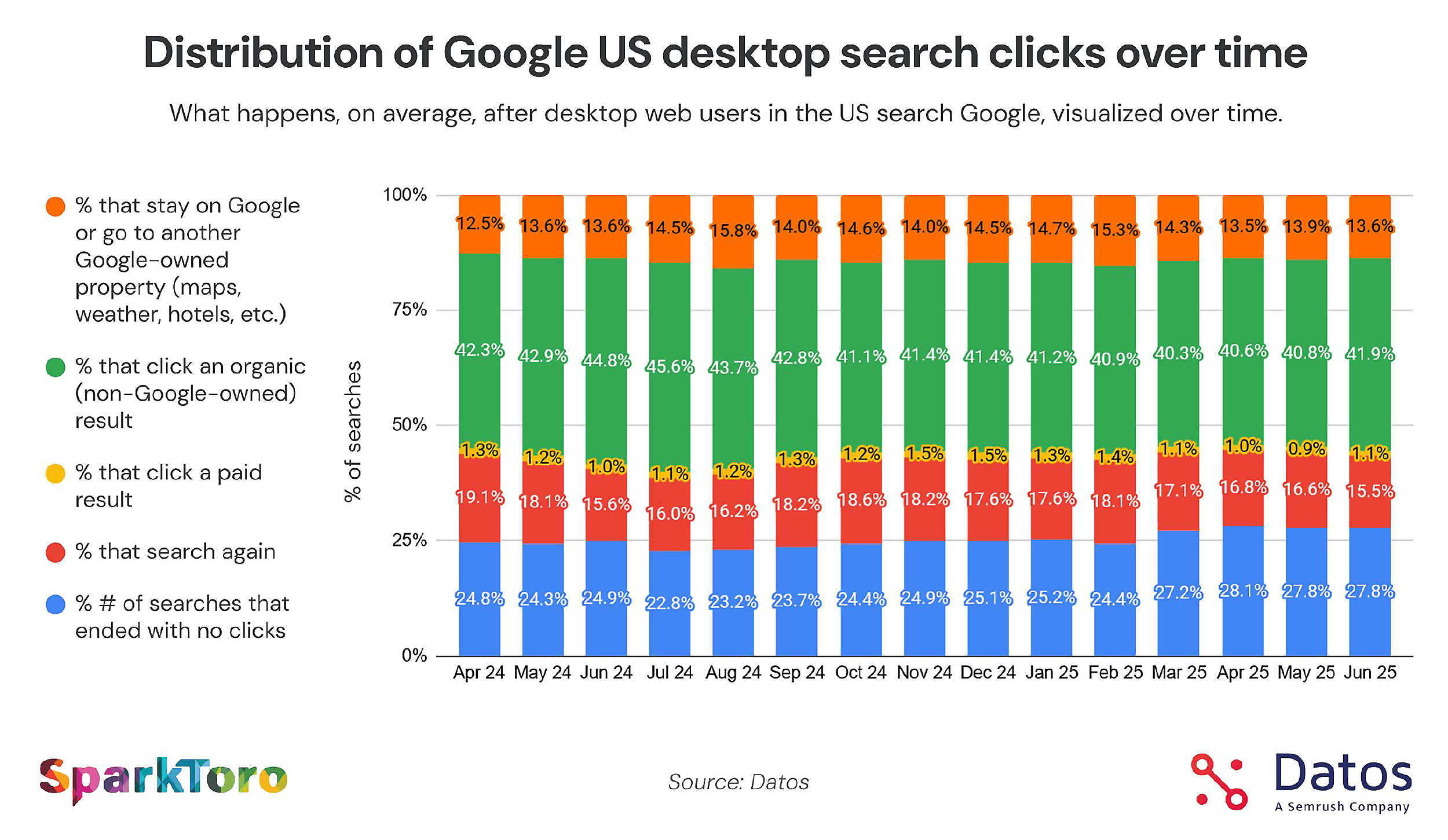
While the number changes are small, they’re continuing to move in the direction of no-click searches. AI Overviews give people the answers they need at a glance, and website traffic is taking a toll as a result.
Aside from these trends in Google search, ecommerce blogs also face an uphill battle against big players like Amazon or Walmart.
With all of this in mind, you might be wondering: is it still worth the effort to build an ecommerce blog?
Here’s a real world example that shows why it still matters:
Pet care brand Petlibro has been around since 2020, but they didn’t start posting on their blog until 2022. Semrush’s Domain Overview suggests their organic growth has been pretty substantial since then.
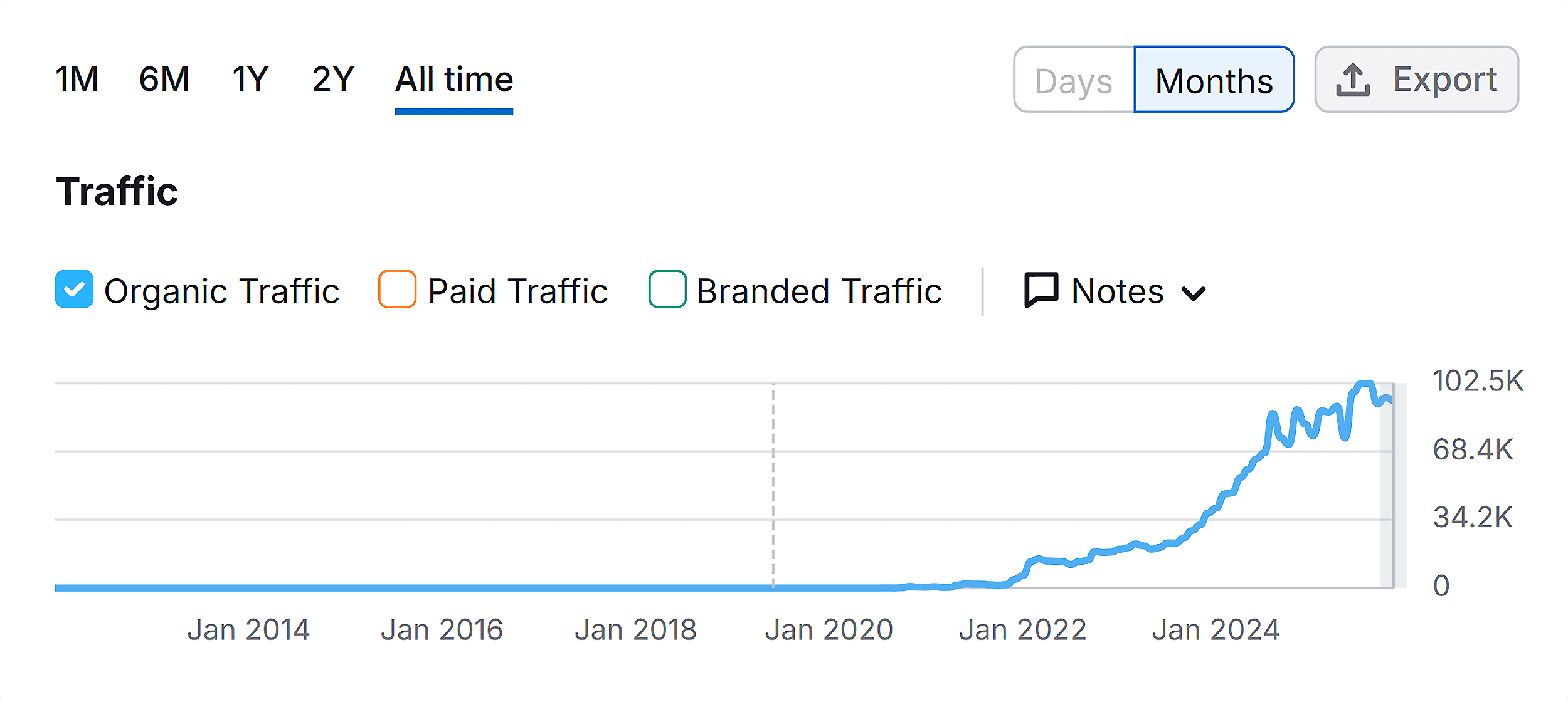
Their website is ranking organically for over 25,000 keywords and stands in the first result for almost 1,500 of those.
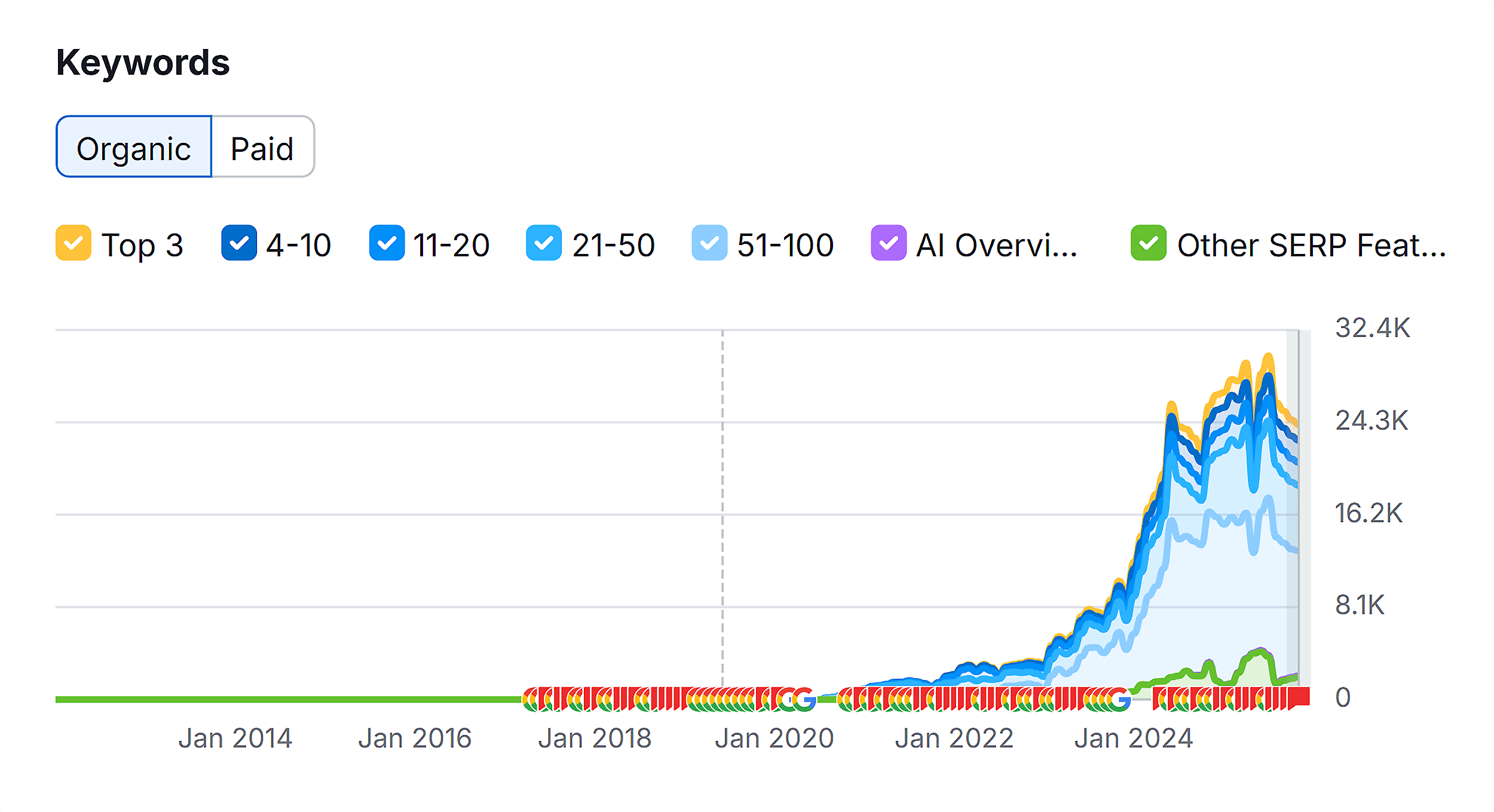
And not only that: Petlibro is being mentioned and cited by AI search engines — more than 700 times.
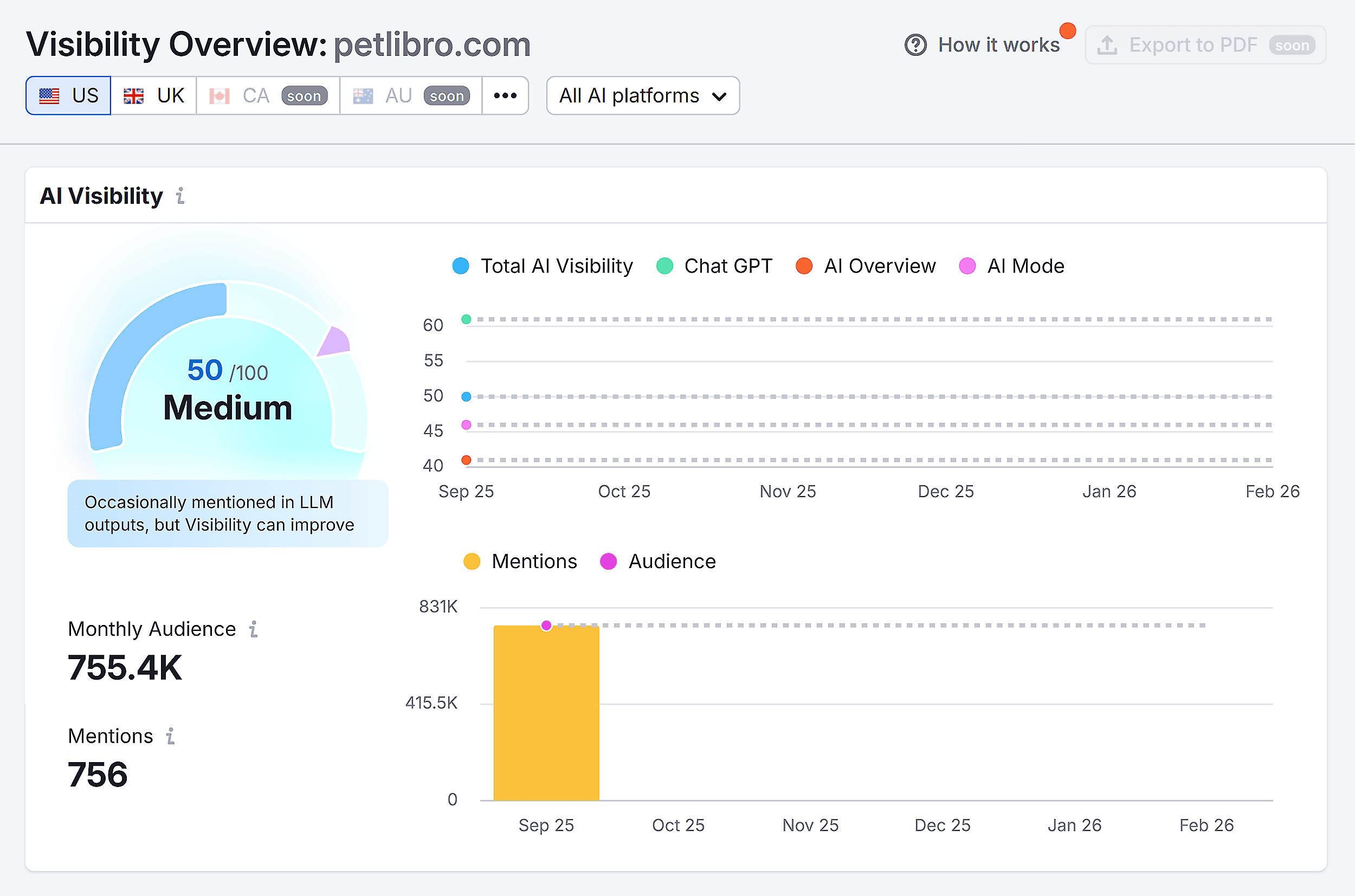
AI search references Petlibro’s blog articles and mentions the brand directly in its response.
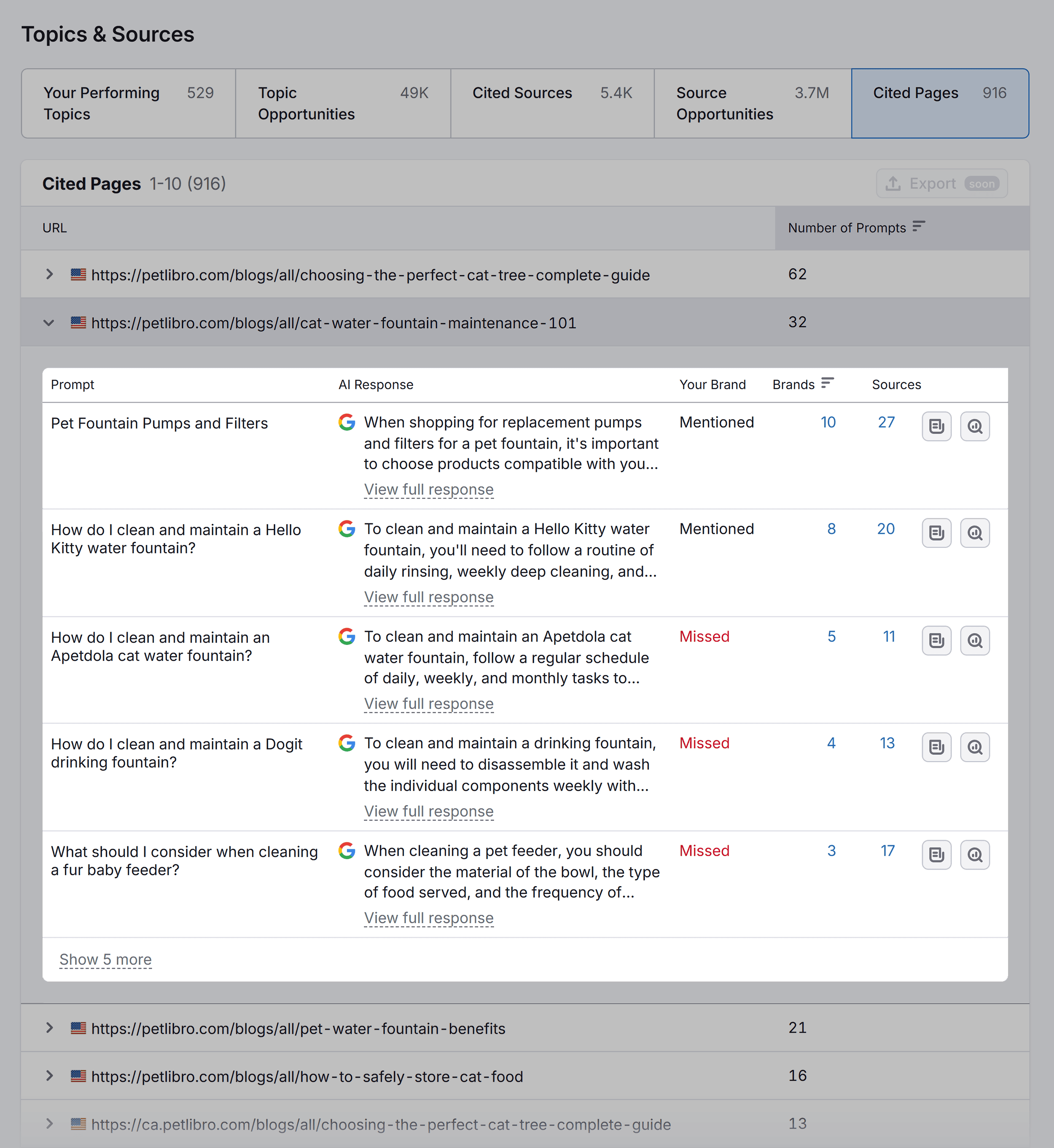
Their blog isn’t a separate entity to their ecommerce site. It’s a strategic tool that helps their brand get seen both in Google and in AI search — and get more conversions in the process.
Here’s the point: blogging is still valuable, especially for ecommerce brands, even in the era of AI search.
The difference between today and ten years ago is that the main goal isn’t traffic: it’s delivering clear, distinctive value for the reader.
Basically, you need to build something that AI can’t.
We’re going to dive deeper into ecommerce blog examples that are currently seeing big results and show you how to apply their strategies to your own brand.
What Makes an Ecommerce Blog Successful?
The more you study top ecommerce blogs, the more patterns start to emerge.
Before we explore each of the following examples in depth, keep an eye out for these key aspects of successful ecommerce blogs:
- They know exactly who they’re talking to: All the top ecommerce blog examples we’ll discuss have a very clear target audience. And the content speaks directly to those people.
- They understand intent: People search for certain terms just to gain information. Others search to learn about products, and others search because they’re ready to buy. The best ecommerce blogs know the difference between those different search intents. Then, they can create content that matches the intent of the search.
- They present information in a way that’s easy to read and understand: There’s no specific format that guarantees success. But each example uses blog design essentials to make the information understandable. Their content also includes strong introductions and content that’s unique and interesting.
- They integrate their store directly with their blog: The most successful ecommerce blogs are focused on conversions over traffic, and use smart integrations to showcase their products on the blog.
- They prepare content to do well in the age of AI search: These blogs show up consistently in AI search by producing the kind of material AI loves to reference and mention. You’ll see how they create content that’s well structured, authoritative, and unique.
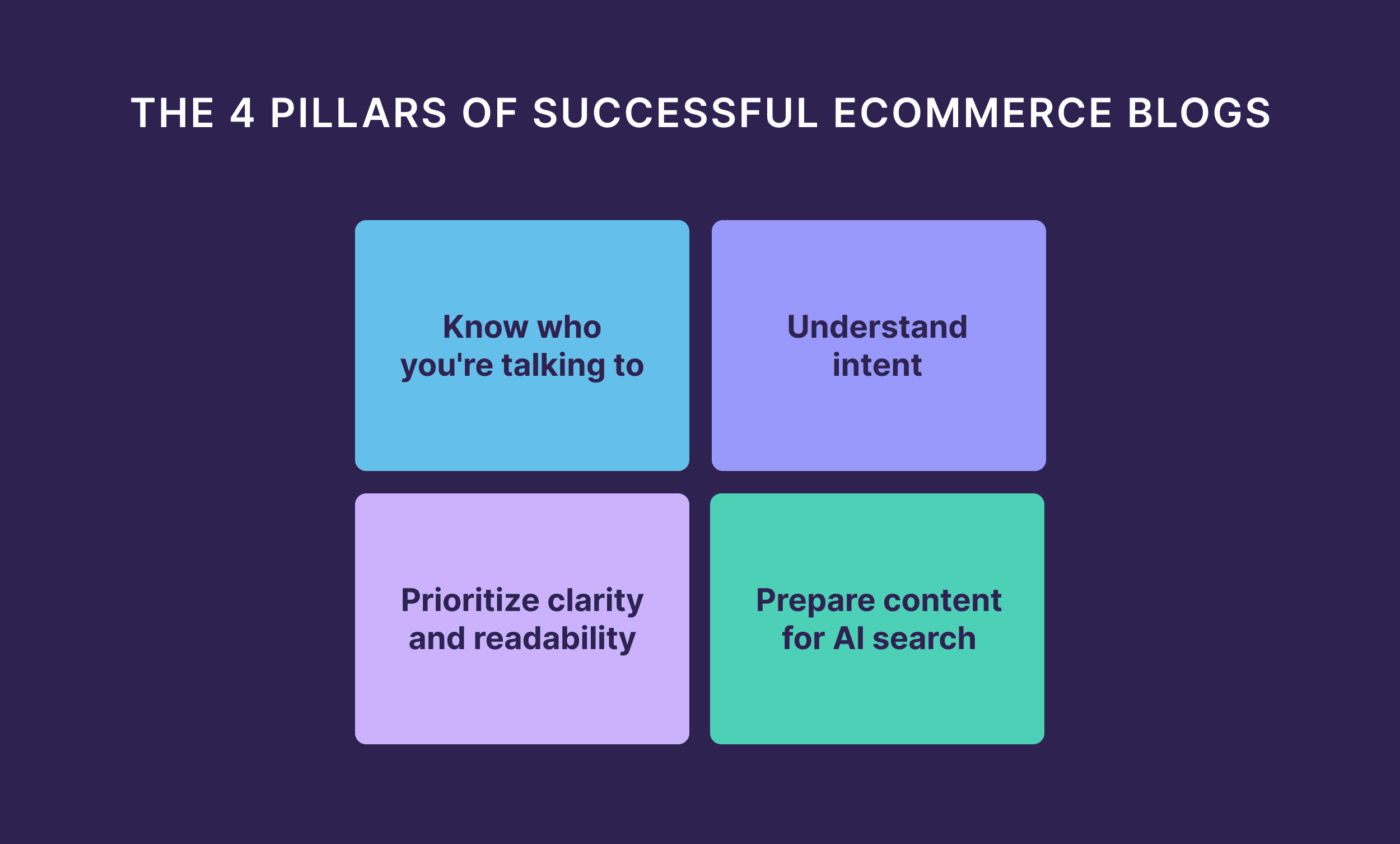
Now let’s see seven ecommerce blogs that exemplify these principles.
Further reading: How to Start a Blog: A Step-by-Step 12-Month Action Plan
Ecommerce Blog Examples You Can Learn From
The goal of any ecommerce blog is to do more than just build traffic. You also want to build authority, win visibility in both Google and AI search, and nudge readers closer to buying.
The following examples cover a range of categories and company sizes. While they may not all have tens of thousands of visits per month, they’re all using their blog as a conversion tool and a way to get seen both in Google and in AI search.
And they all have something to teach you about staying visible, memorable, and findable as an ecommerce blog.
Note: We got the numbers for each of these from Semrush’s SEO Toolkit. Traffic numbers aren’t going to be 100% accurate (only the brands themselves will have the most up-to-date numbers). But it’s still useful for understanding broad trends.
1. Garmin
- Industry: Consumer electronics
- Organic blog traffic: 61.8K
- Backlinks: 77.7K
- Keywords: 46.1K
In the world of smartwatches and specialty sports gear, Garmin truly stands out. Their blog has grown consistently since mid 2022.
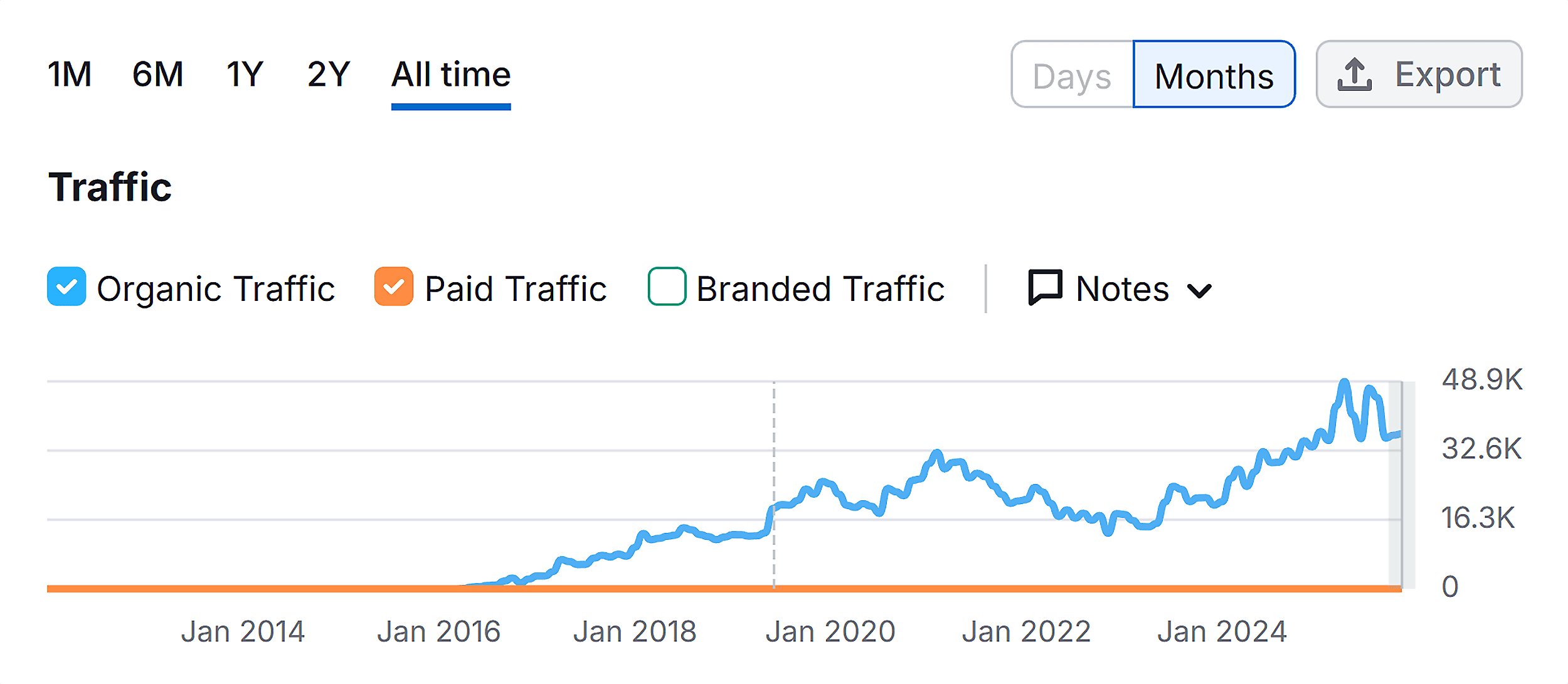
So, what makes this ecom blog stand out?
First off, the articles are a healthy mix of informational and commercial content.
For example, this article on finding your V02 max ranks for 4.6k keywords, and ranks #1 for 95 of those. It even shows up in the AI overview for a couple of difficult keywords.
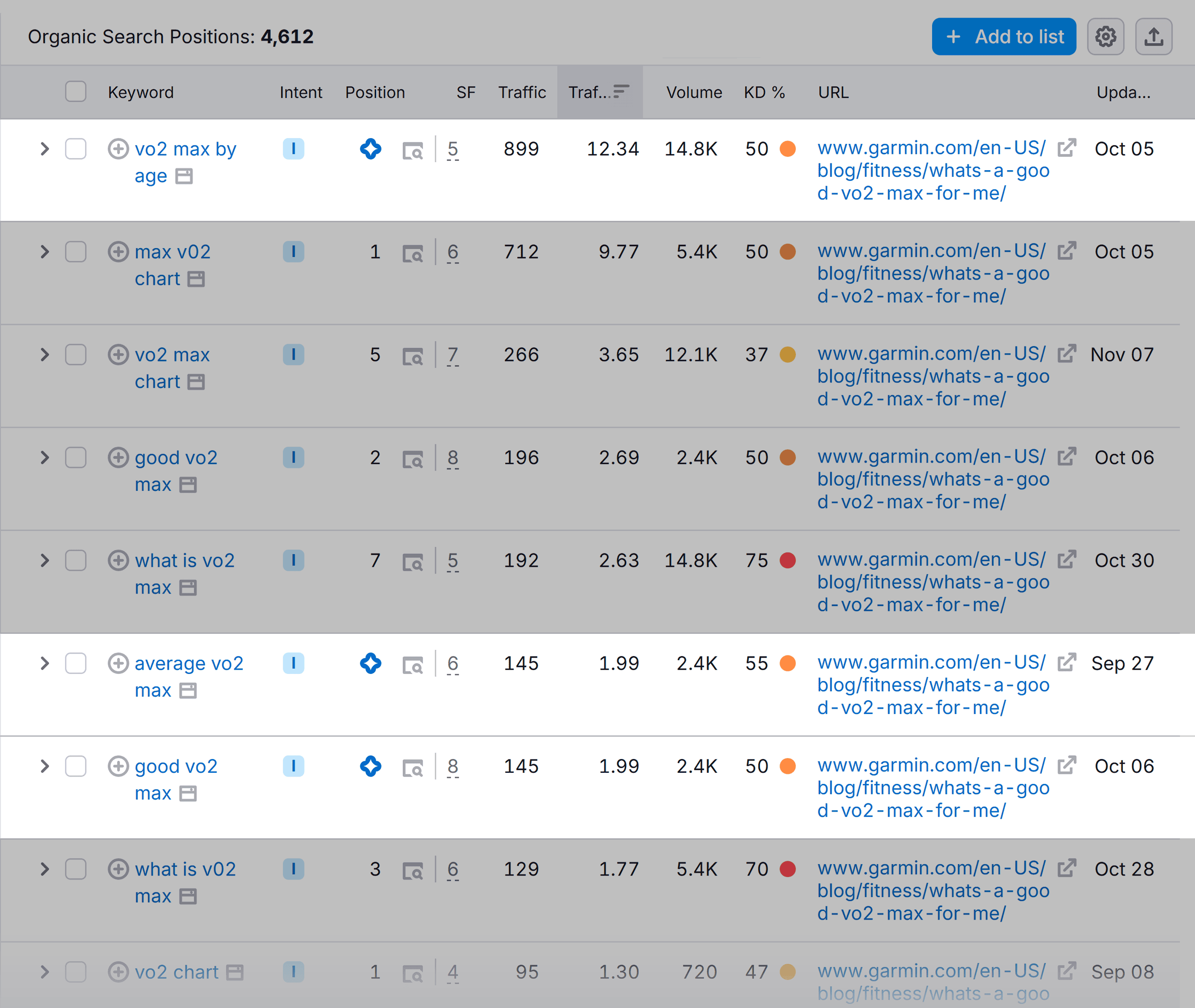
The article is a deep-dive into a complex topic their audience is interested in. And while someone searching “good v02 max” may not be immediately interested in buying a watch, Garmin still includes plenty of ways to explore their products from this blog post.
For instance, readers can see CTAs to some of their most relevant watches in the sidebar, and they also see links to product categories in the text.

But Garmin also knows how to focus their blog on buying intent, which is why they also rank for terms like “Garmin aviation watch.”
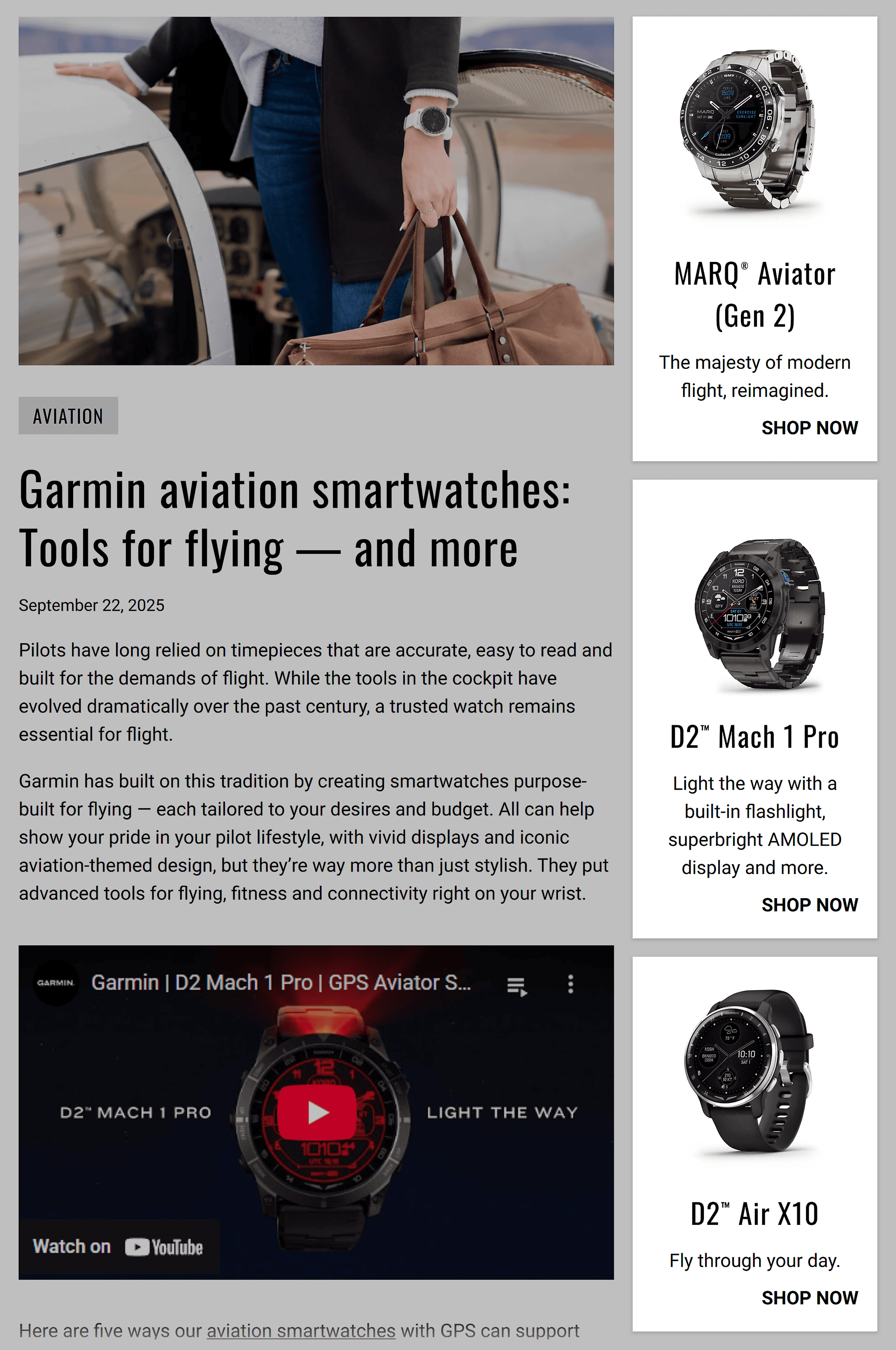
From this single keyword, Garmin’s article on aviation watches gets 3.7k monthly organic traffic by ranking for 63 keywords. (I guess pilots really like their watches.)
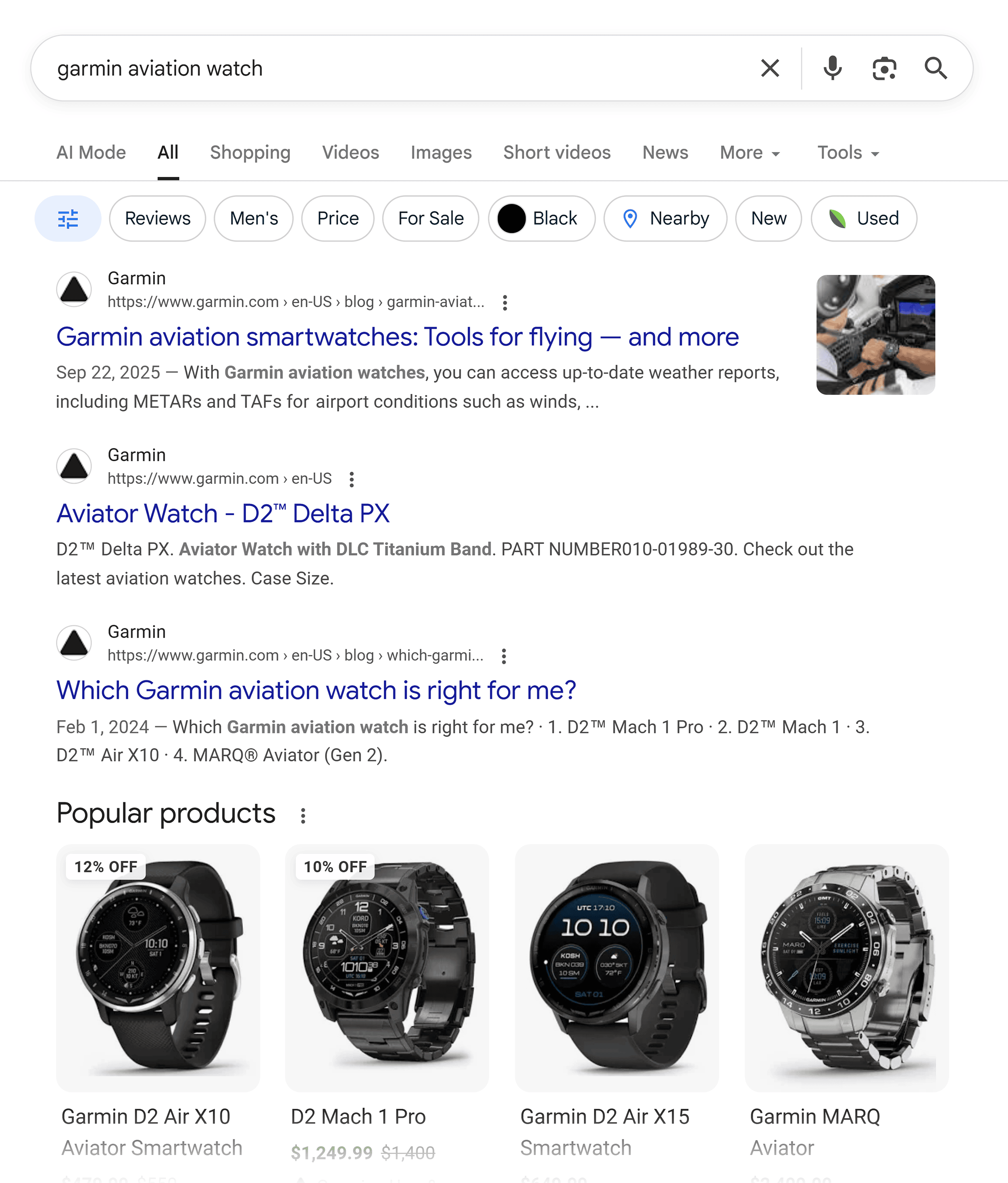
But more than just creating content for search, Garmin has cracked the code on creating content that gets mentioned by AI.
Just look at Garmin’s incredible AI visibility score, with over 52k mentions:
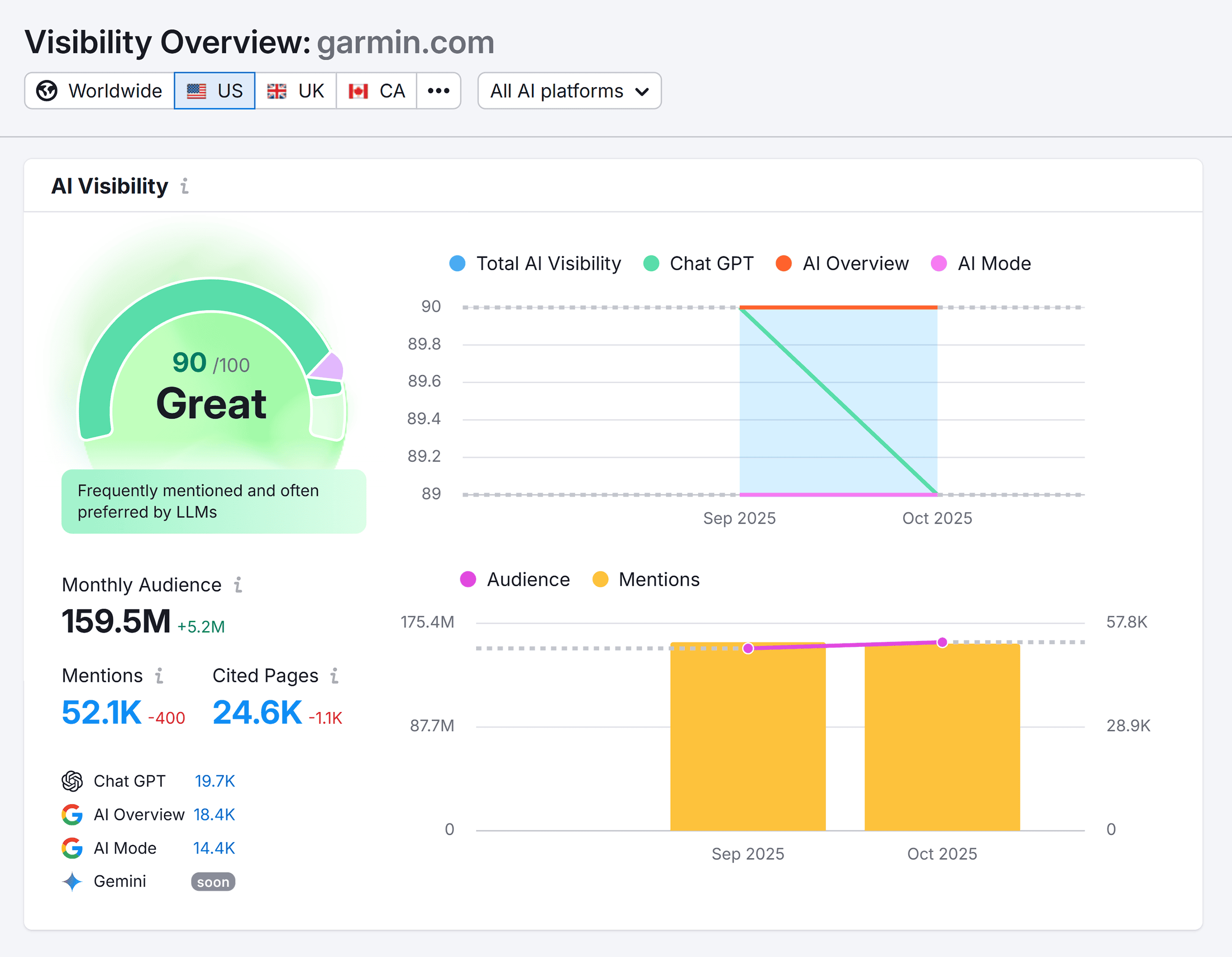
AI search loves to highlight product information directly from the brand. Which is why Garmin’s clear, detailed support documentation appears so often in AI search results.
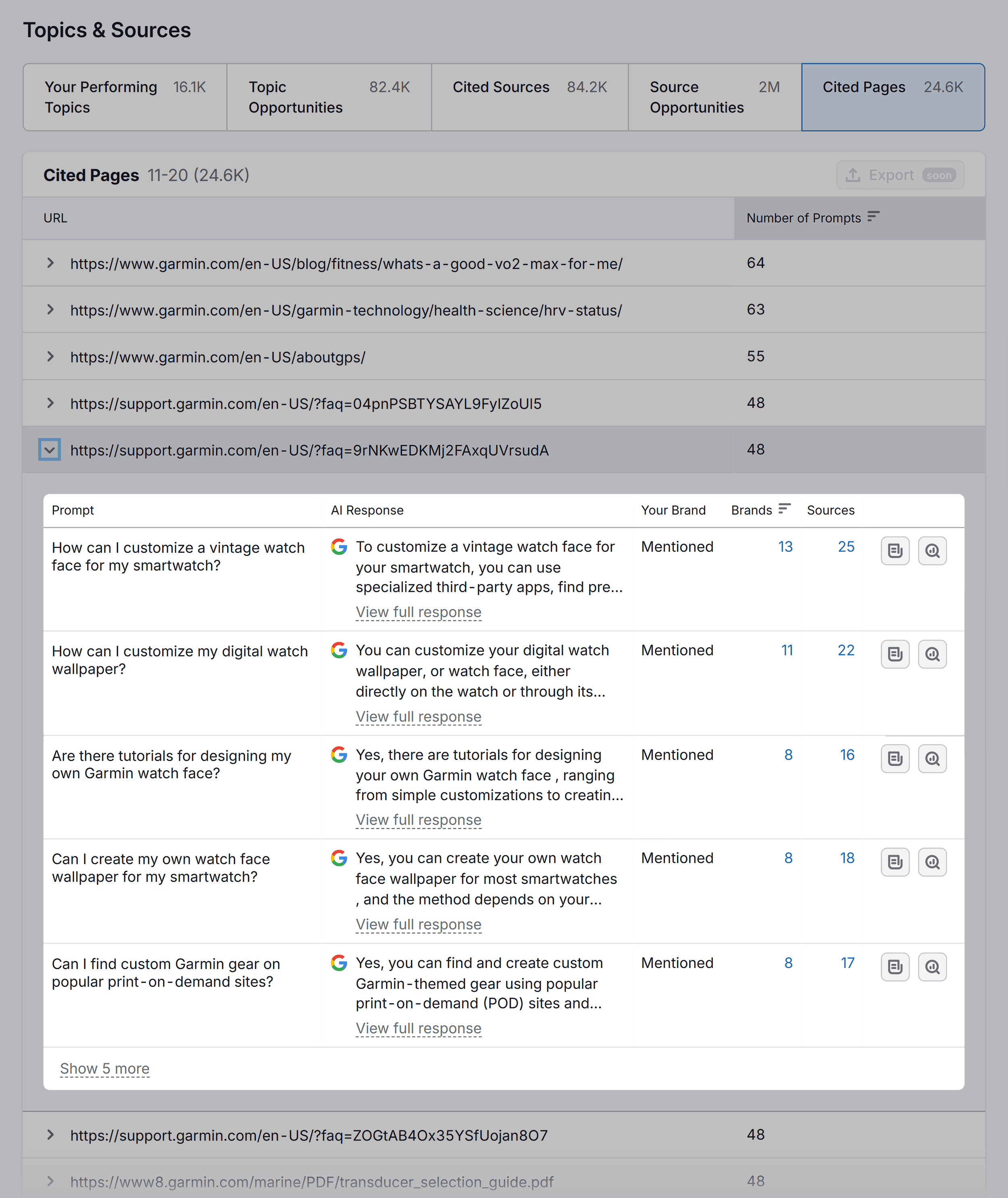
But their blog posts are also cited by AI to respond to product-related questions, like which smartwatch has the best battery life.

Something else that Garmin has done well is combine their content efforts on their owned channels with mentions across the web. Whether it’s tech review sites, YouTube videos, fitness blogs, or Google reviews, Garmin’s products are mentioned positively in a lot of places.
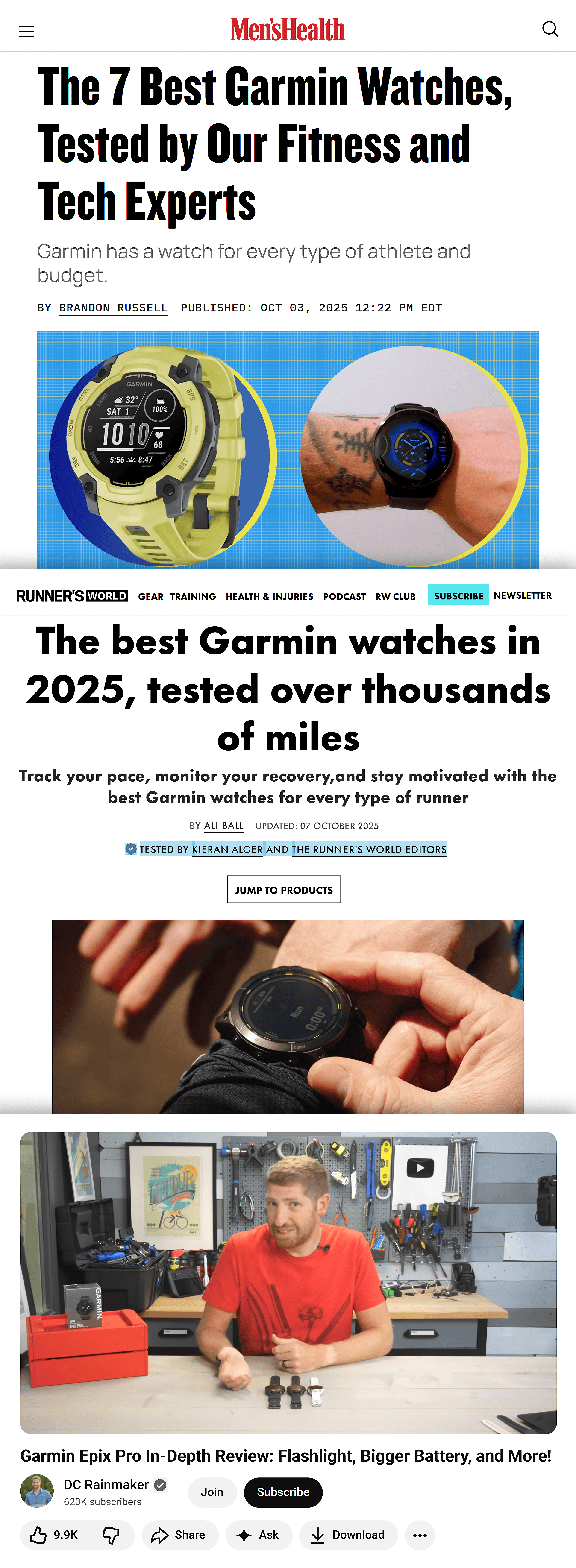
The result?
Semrush’s AI Visibility Index found that Garmin ranked #4 in AI Share of Voice for consumer electronics brands. They sit right at the top with heavy hitters like Apple and Google.
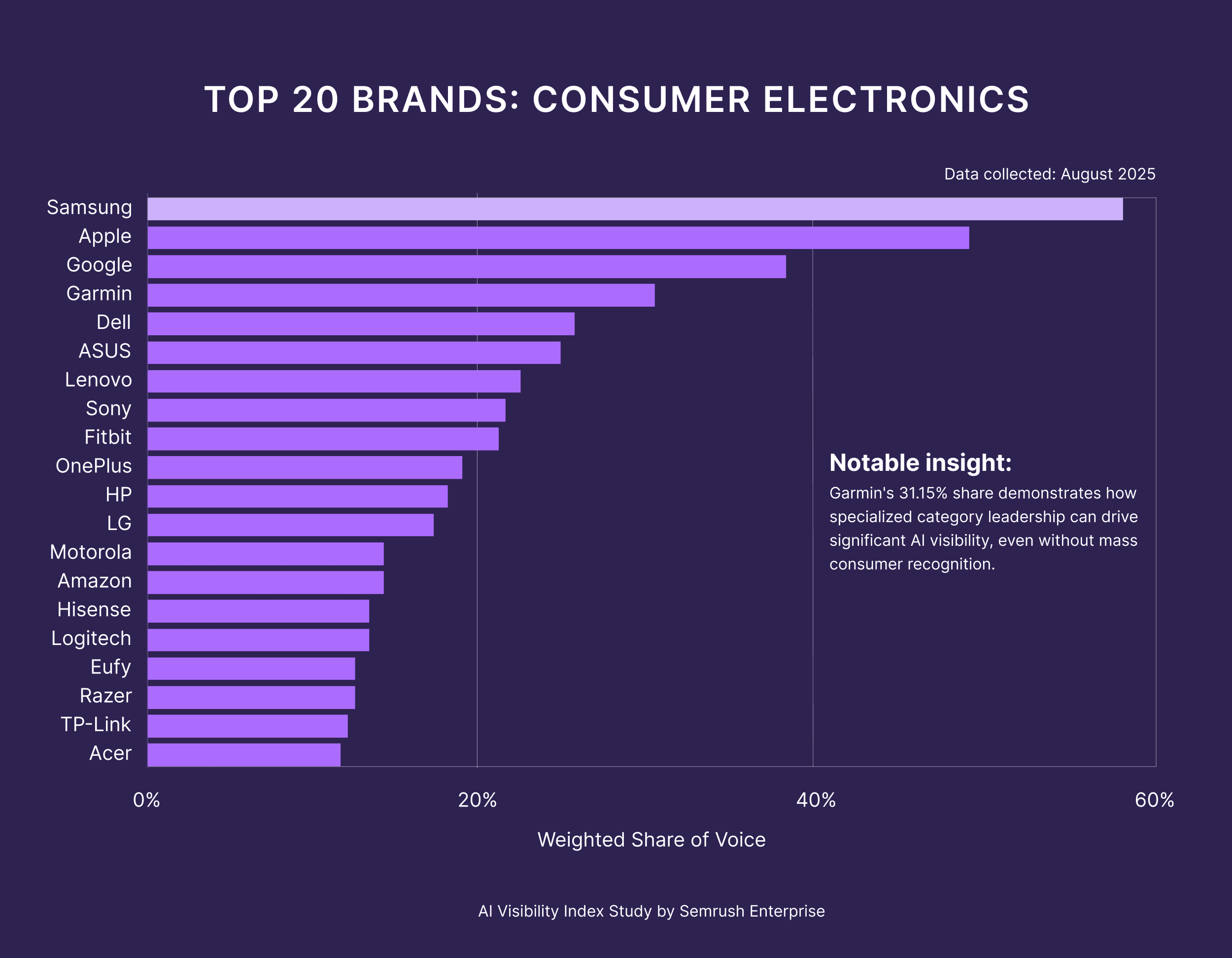
Key Lessons from Garmin’s Blog
Garmin is a multi-billion dollar company, well-known in its space. But importantly, they dominate their category. When you own a category (like smartwatches), it’s much easier for AI to surface your content and products to users.
Another company doing this is Patagonia. They dominate the category of ethical fashion, and have gained 21.96% of the AI Share of Voice (for Fashion & Apparel).
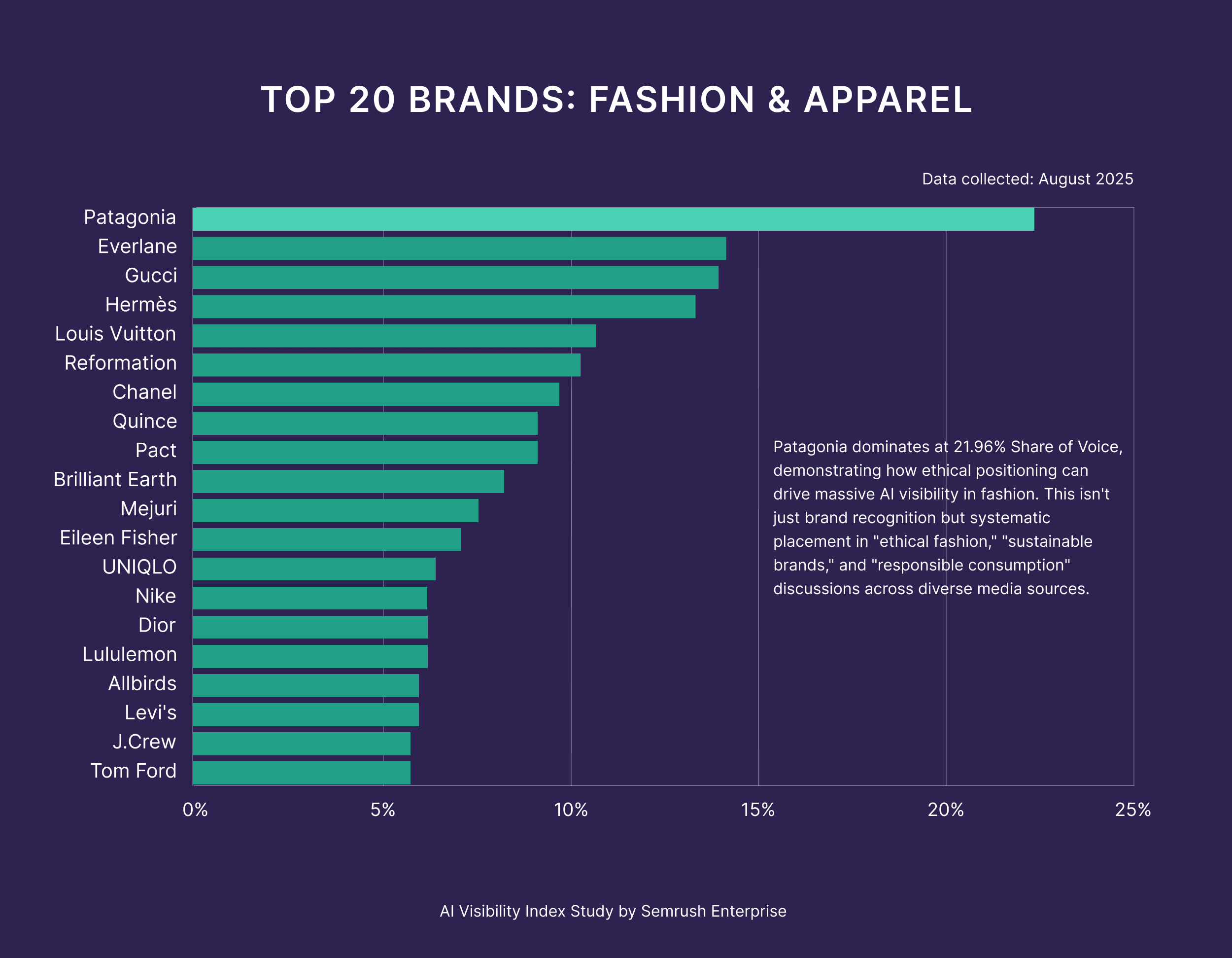
Another lesson from Garmin’s blog is the importance of providing clear information about your products.
AI search results tend to cite brands as authorities on their own products. But if you don’t answer the questions searchers have about your products? AI will usually attempt to base its answers on someone else’s article (whether that information is correct or not).
Finally, remember that your blog isn’t a solo marketing effort. When you partner with content creators outside your owned channels, you can expand your visibility in AI.
The more positive mentions your brand gets, the more likely you are to see yourself in AI answers and overviews.
Further reading: 7 Ecommerce Link Building Strategies That Work in 2025
2. Petlibro
- Industry: Pet products
- Organic blog traffic: 6K
- Backlinks: 275
- Keywords: 3.4K
We’ve already introduced you to Petlibro above: showing the power of blogging for ecommerce brands. Not only do they show up in search results, Petlibro’s blog posts are also being cited and mentioned by AI.
Take this post for example:
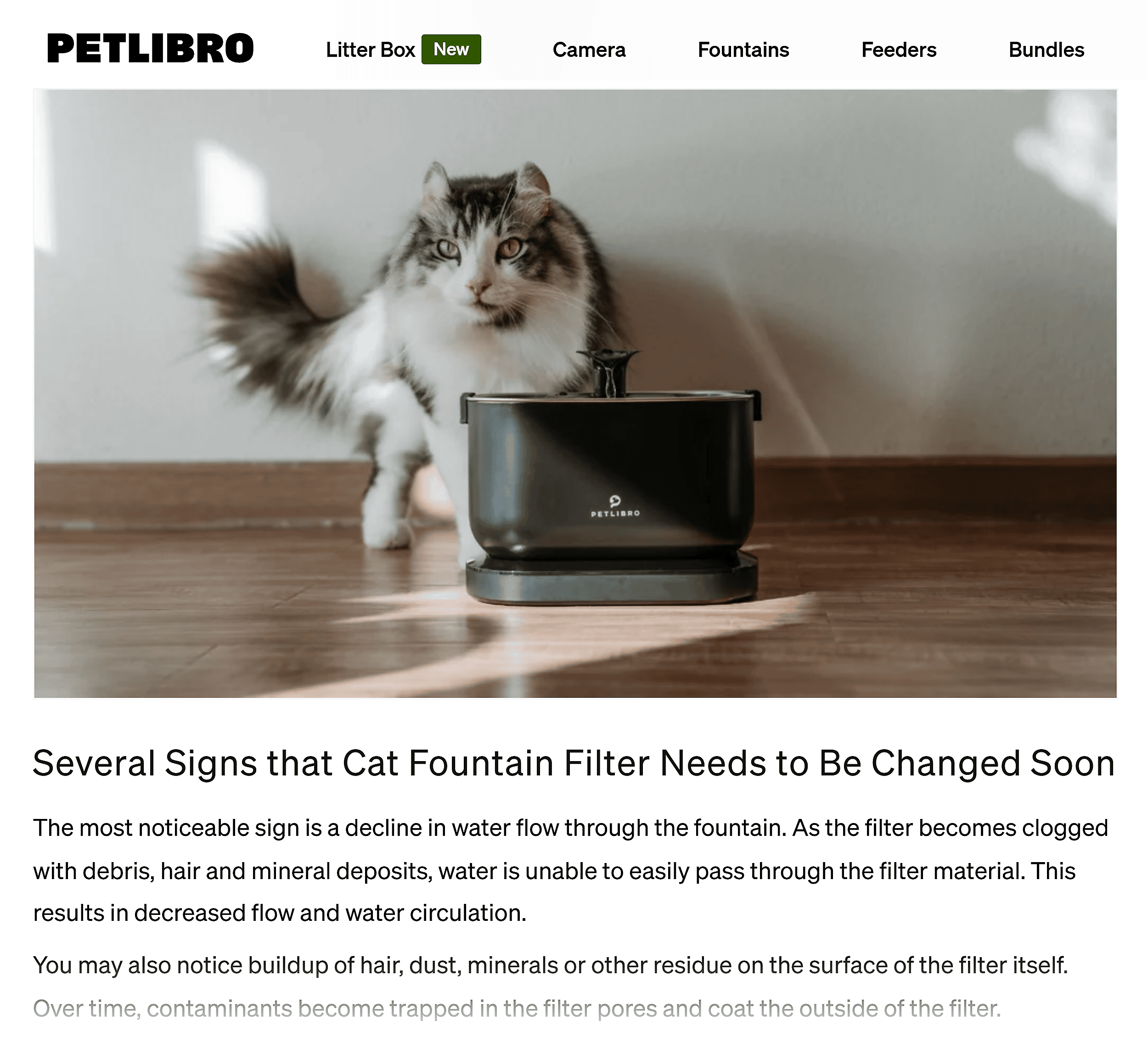
This informational post answers the question of how often to change the filters in a cat fountain. It’s not too long, but it answers the question clearly and gives just the right amount of detail.
So, along with ranking for 44 different keywords, it’s also showing up inside the answers given by ChatGPT and other AI search tools.
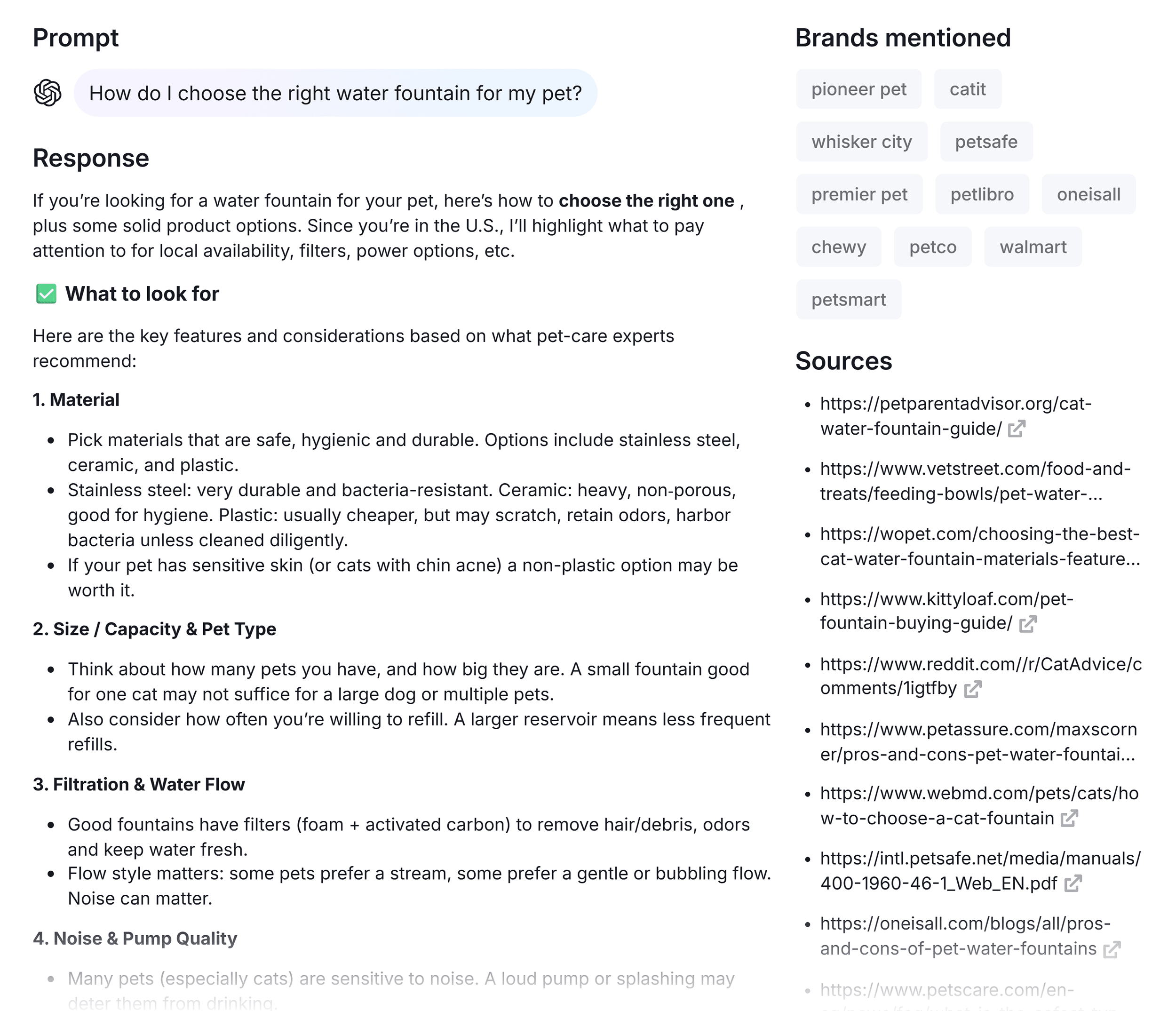
Another post, explaining why cats bring you toys, ranks in the top 10 for 14 keywords, and appears in the AI overview in Google.

But Petlibro doesn’t just post informational articles. They do a great job of striking the balance of intent, focusing on content that matches what the searcher is looking for.
For example, this blog article about choosing the perfect cat tree gets more than 500 visits per month and ranks for 127 keywords. Best of all, most of these keywords have commercial or transactional intent.

Key Lessons from Petlibro’s Blog
First off, Petlibro shows it’s important to develop a healthy mix of informational and transactional content.
Going after keywords at the top of the funnel works to build your authority. But content that helps point people to the right products when they’re already in the mood to buy brings more immediate results.
Next, for your brand to be visible in both Google and AI, you need to answer the questions people are asking. You can start by doing research on forums, but also try tools like Semrush’s AI SEO toolkit for prompt research.
This can give you an idea of the prompts people are using in AI platforms, and which websites AI is currently referencing or mentioning directly.
For example, let’s try searching for “home security camera systems.”

In the Prompt Research report, you can see AI volume for that topic, how difficult it is to gain visibility, the intent of the questions in this topic, and more details about the prompts used and the brands mentioned.
This gives you a great starting point to see what people are asking about within your topic. Then, you can create content that answers those questions.
3. Great Jones Goods
- Industry: Cookware
- Organic blog traffic: 11.6K
- Backlinks: 1.7K
- Keywords: 4.9K
Great Jones Goods’ blog stands out with fantastic visuals and content that is tailored to their audience.
Honestly, just looking at this blog is making me want to get into the kitchen and bake something.
Their blog has two main sections: recipes and personal profiles.
You gotta love these recipe posts. Just take this one for arroz con gandules:

Each recipe has a different author. So each post has a very personal feel.
It’s just like your favorite recipe blog, but without so many layers of fluff.

The posts also mention the cookware the author used (subtly highlighting their own products).
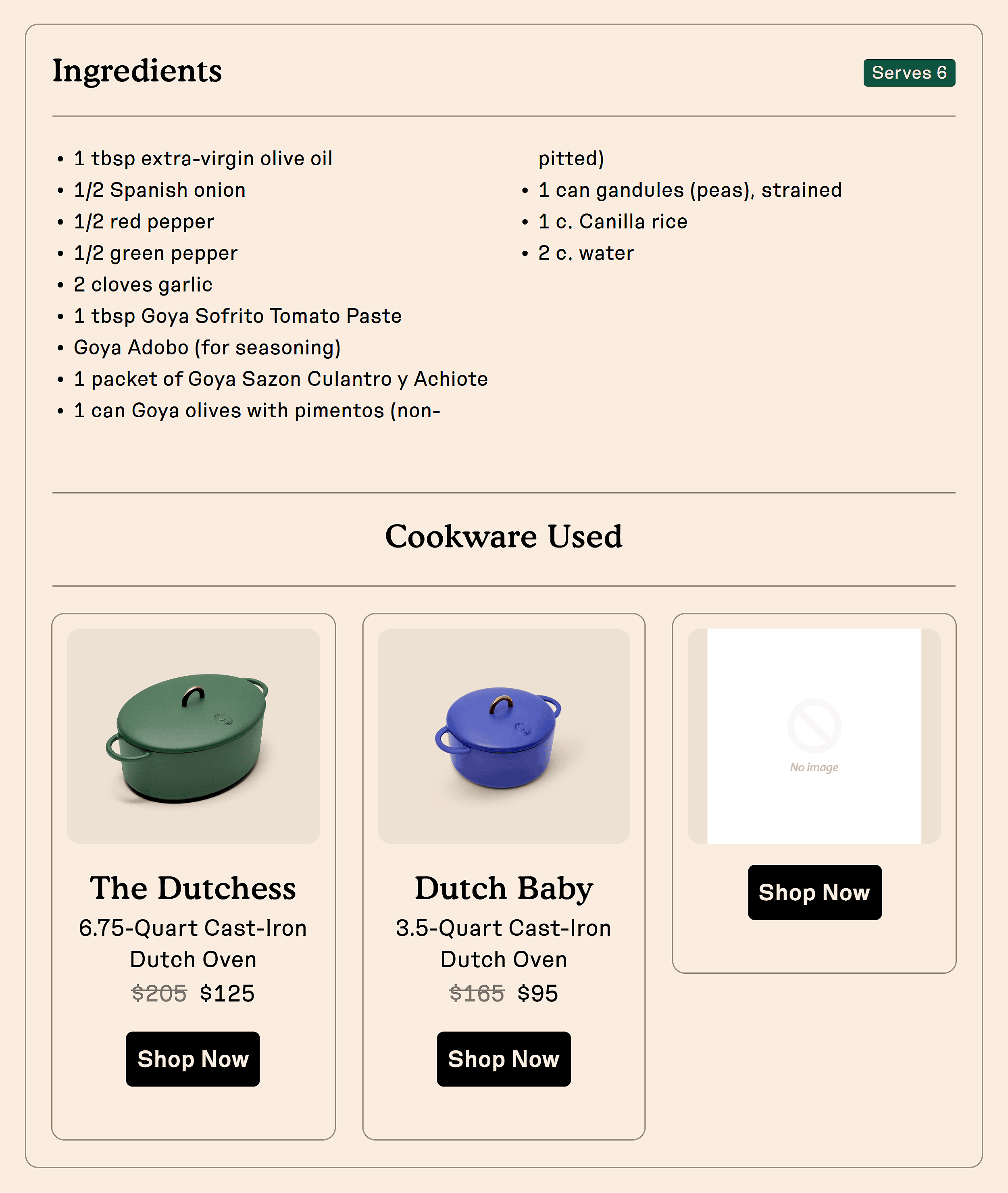
And each recipe is also accompanied by beautiful step-by-step visuals.
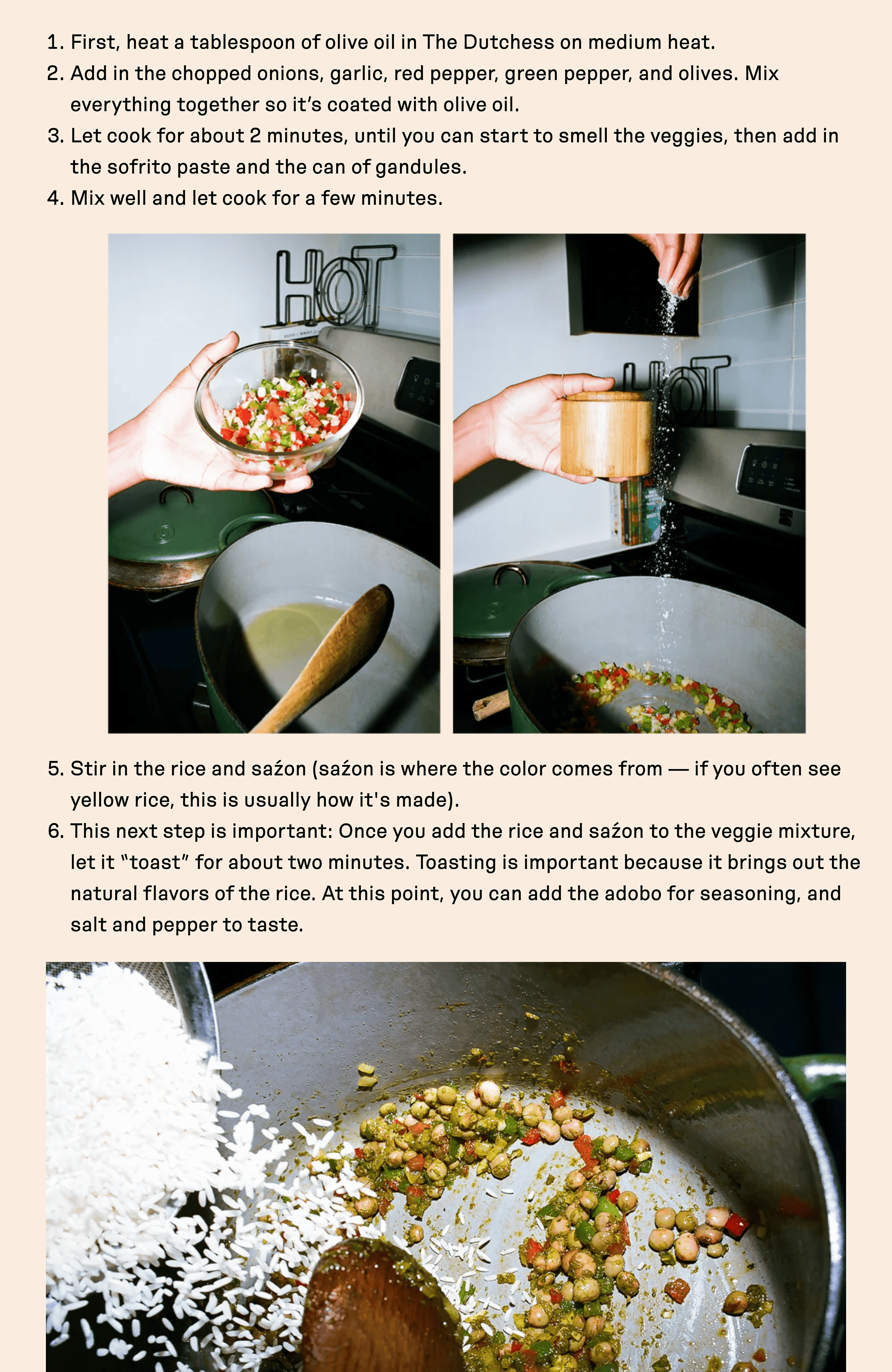
This all looks great: but what about the results?
Great Jones Goods isn’t getting millions in traffic. But their content does show up in all the right places.
For example, their profiles of chefs and well-known people rank in search results:

And their recipe posts also show up in AI overviews:

Their blog is consistent and targeted at their specific audience. Instead of being “sales-y,” they focus on being part of the community that they want to sell to.
Key Lessons from Great Jones Goods’ Blog
Beautiful, descriptive visuals are a key component of high-quality blog content. Plus, it’s a great way to make your blog stand out as different. When you’re creating content for your blog, ask yourself: how can I create something that AI can’t?
Great Jones does this by including step-by-step imagery and real-world examples of their products in use. That’s something shoppers love to see, and AI can’t replicate.
Another key takeaway from this ecommerce blog example is to include your community in your content. Great Jones does this with in-depth personal profiles that talk about the joy of cooking — something their target audience shares.

People crave connection with other humans, now more than ever. You can use your blog to become part of that community.
Try including people that the community already knows and loves. This will help your blog be more personal, as well as give you new ways to promote your blog.
Further reading: 25 Creative Ways to Find New Content Ideas
4. Thinx
- Industry: Menstrual products
- Organic blog traffic: 25k
- Backlinks: 1.6k
- Keywords: 22.6K
When your brand is dedicated to a mission, you can use your blog to promote and grow that mission. And that’s exactly what the period underwear brand Thinx has done with their “Periodical” section.
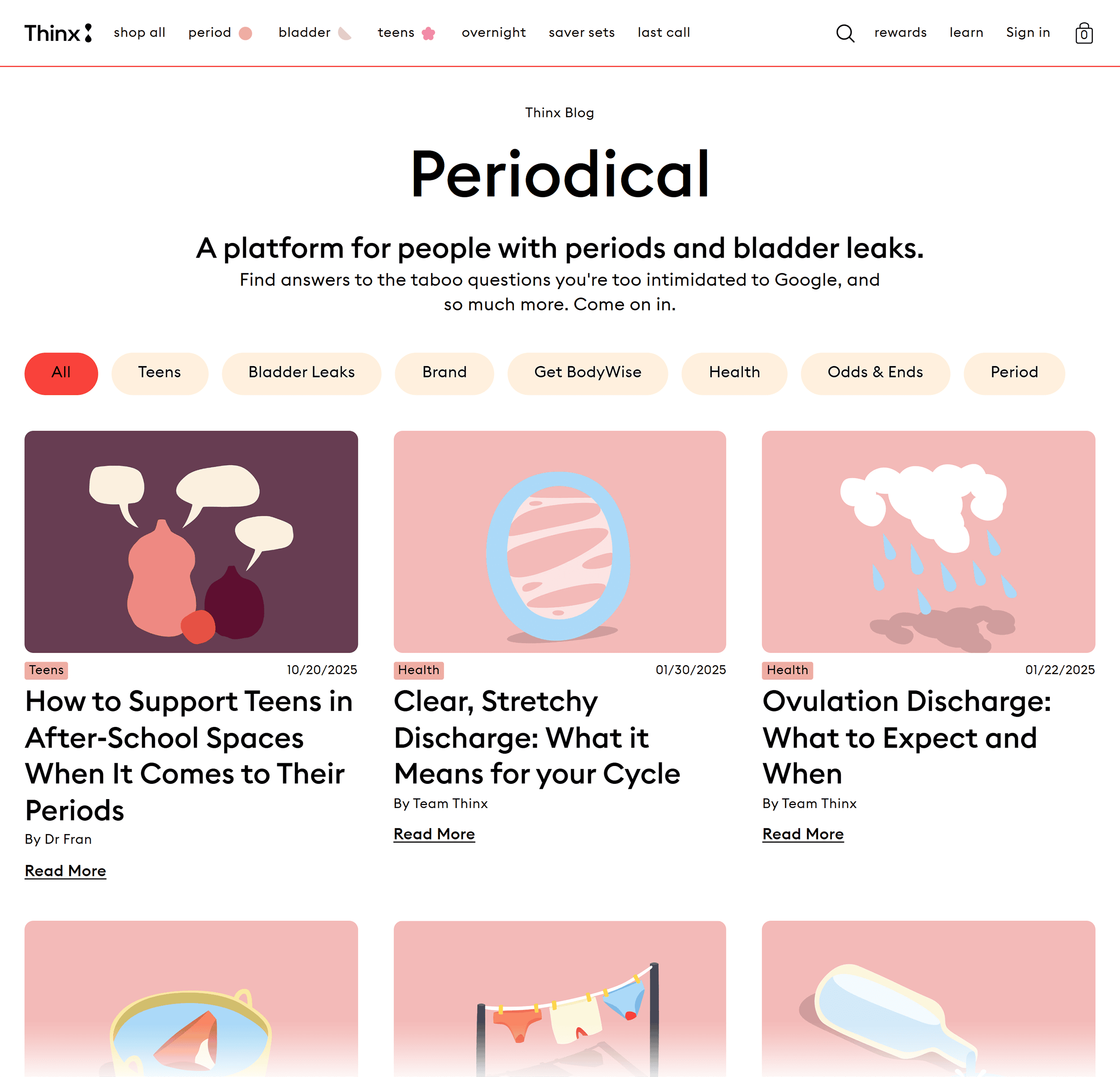
First, they chose an incredibly appropriate name for their blog. Next, they filled it with articles all about menstrual health for women and teens.
The articles are generally on the short side, but answer key questions their audience is asking. And with that, they’re able to rank for difficult keywords like “when do you ovulate,” “period blood clots,” or “period nausea.”
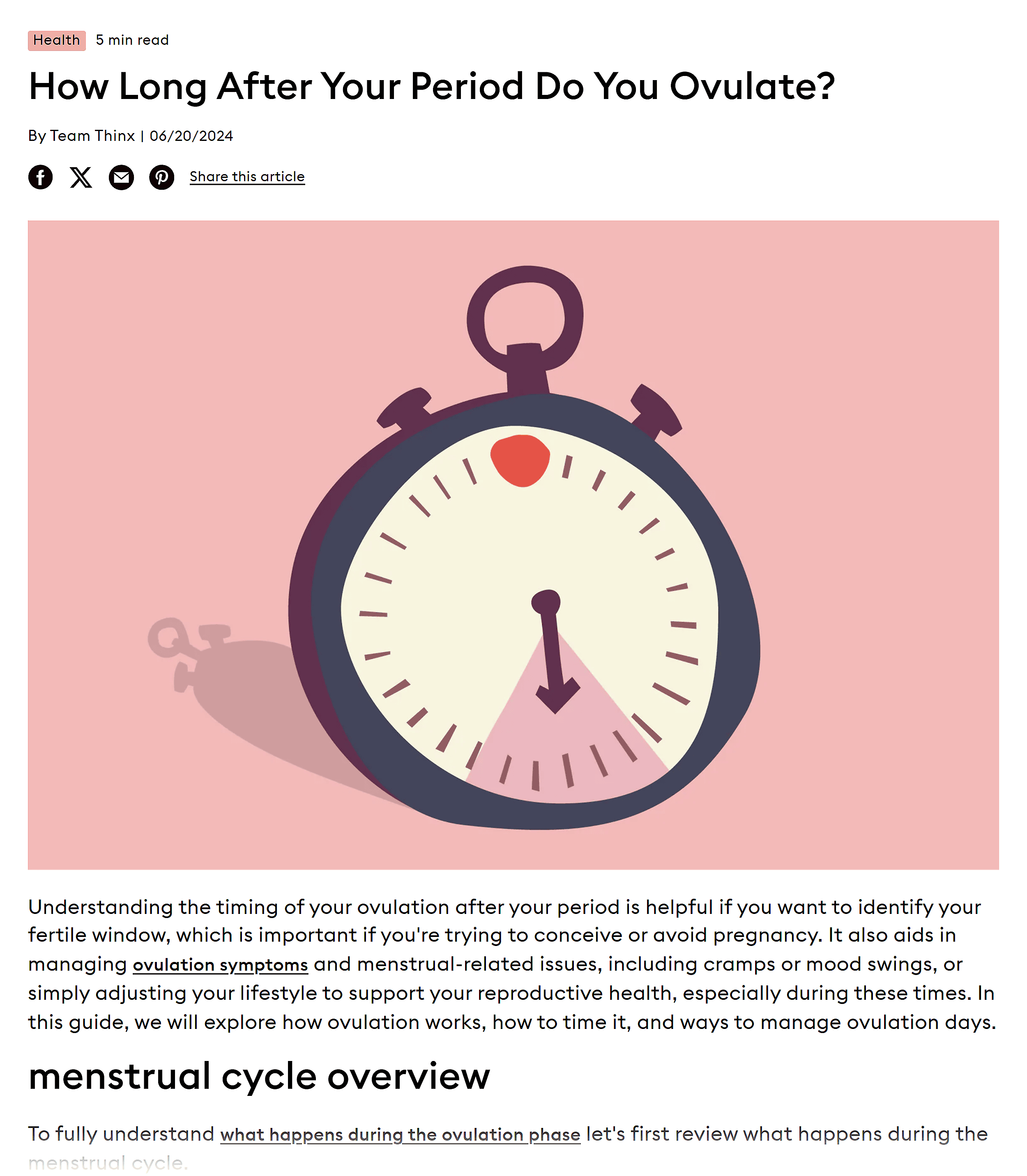
Just this one article on ovulation ranks for 1.3k keywords, most of which are either hard or very hard to rank for per Semrush data.
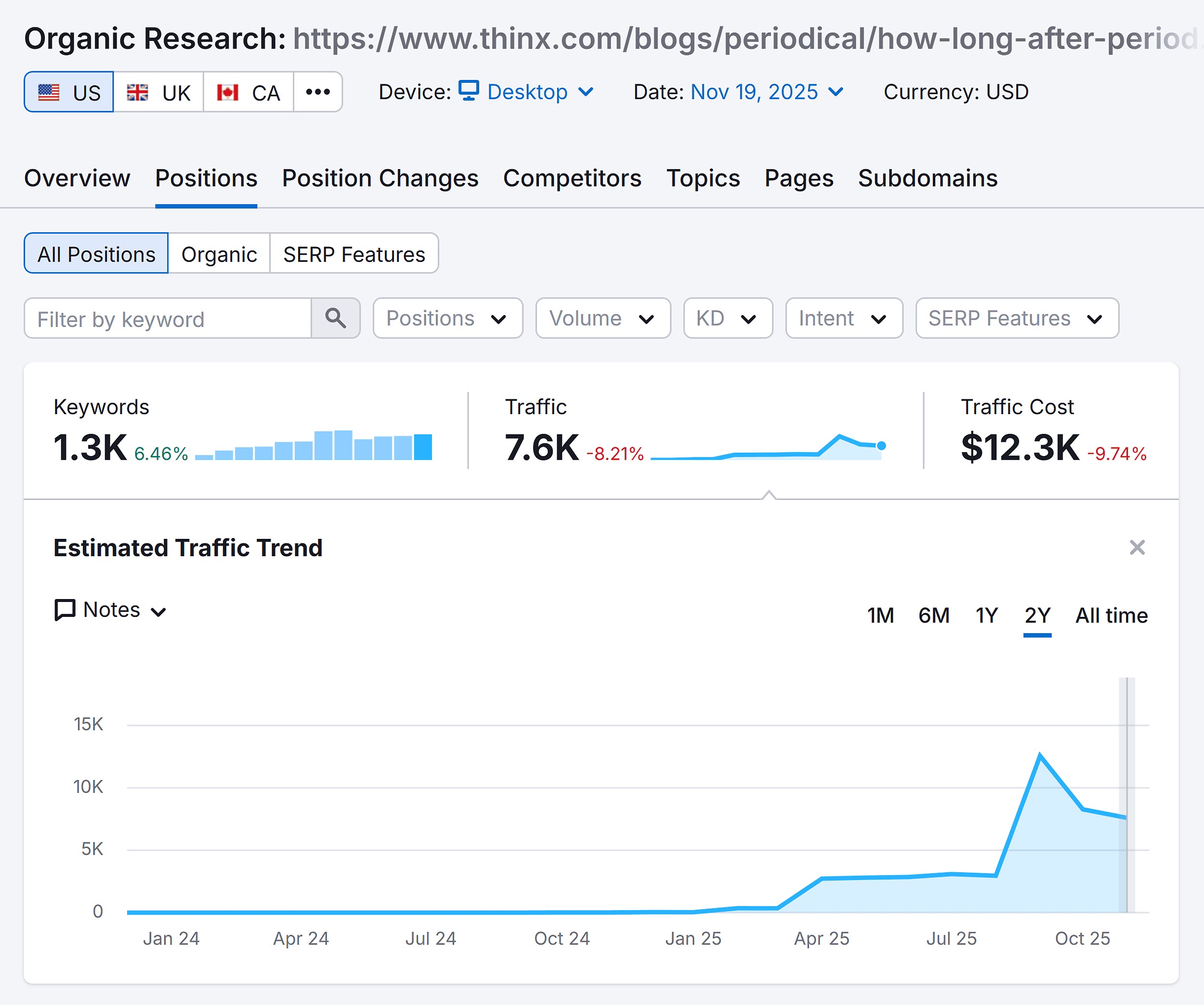
They also build educational resources around the message: Get BodyWise.
Thinx takes body literacy seriously. In fact, they have a dedicated resource page aside from their blog that is built to provide candid, accessible information for people who bleed.

This even includes a series of educational videos from Dr. Saru Bala on women’s health.

Everything they do on the blog supports their mission to make period products and education more accessible to everyone who needs it.
And while their content doesn’t heavily promote their products (possibly on purpose), they do list a handful of relevant products at the end of each blog post. Just the right mix of promotional and educational.
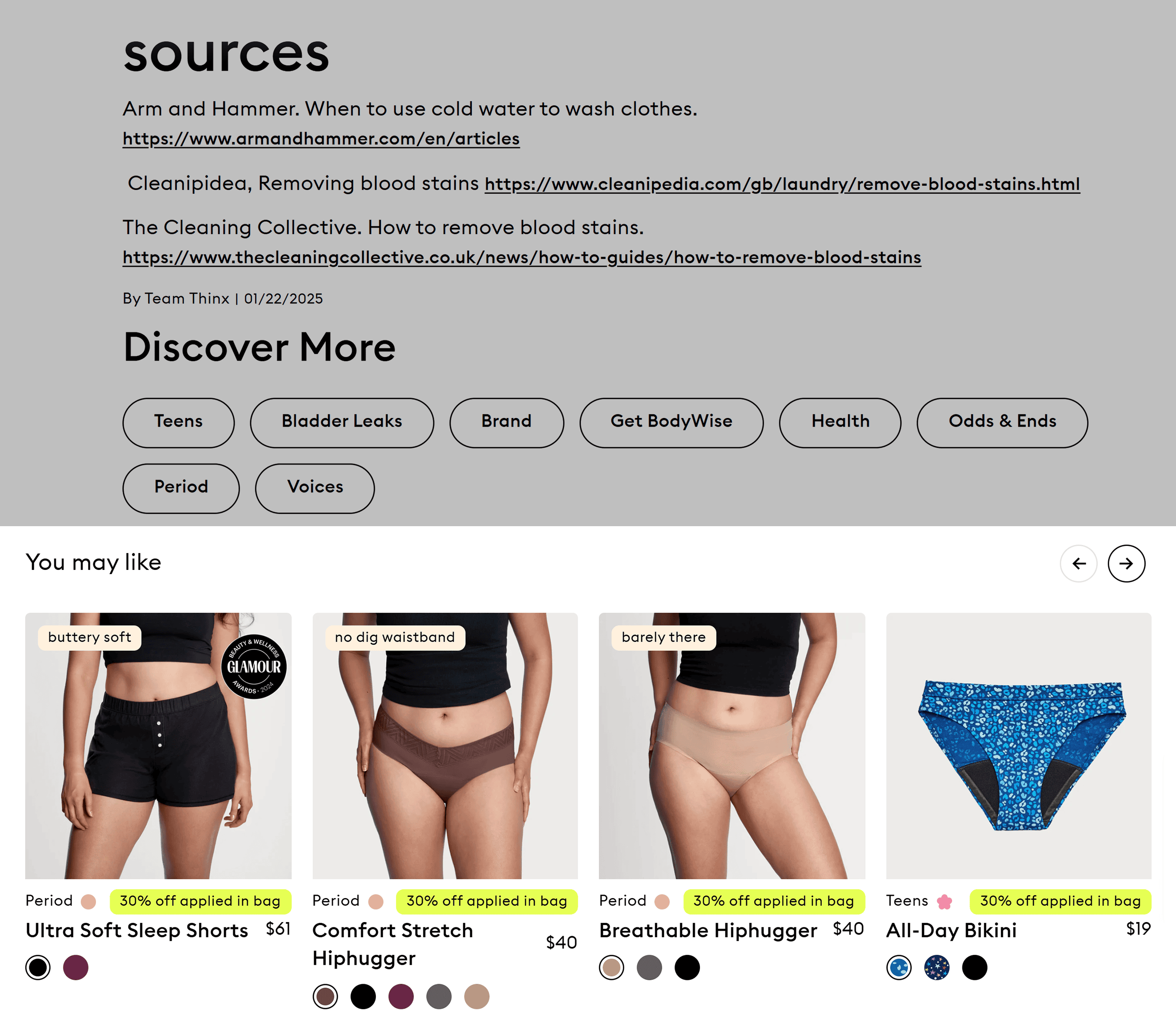
Key Lessons from Thinx Periodical Blog
Your company mission statement isn’t just something that lives quietly on your About page.
It should be a living, breathing part of your business ethos.
It should come through in your marketing.
When your blog has a core mission behind it, the content you create has a clear direction. You’re not just chasing keywords: you’re building educational resources that truly benefit your audience.
The result?
Thinx builds brand affinity naturally over time, increasing the chances that folks will choose Thinx over a competitor when they’re ready to buy.
5. King Arthur Baking
- Industry: Cooking ingredients
- Organic blog traffic: 730K
- Backlinks: 133K
- Keywords: 338K
King Arthur Baking’s blog ranks in the top 10 for some of the most difficult keywords in baking. That includes terms like “baguette,” “pizza,” or “types of cinnamon.”
So, how did they get here?
King Arthur Baking didn’t limit themselves to written content. They created a content ecosystem that also included multimedia content.
Currently, the King Arthur YouTube channel has over 330K subscribers. They post recipes, along with video versions of their podcast episodes.
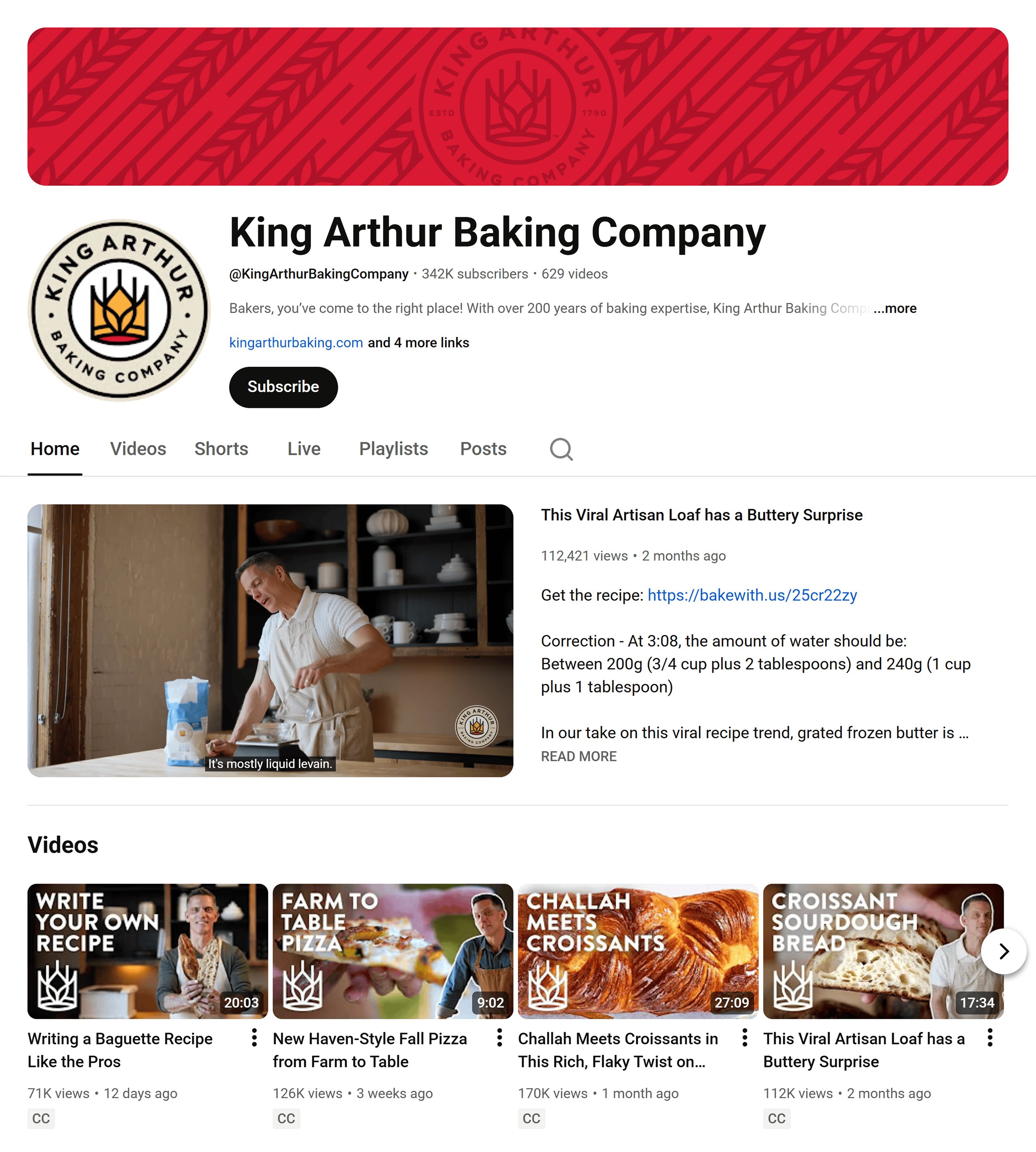
These videos work seamlessly inside their blog posts.
For example, check out their blog post on chocolate chip cookies.
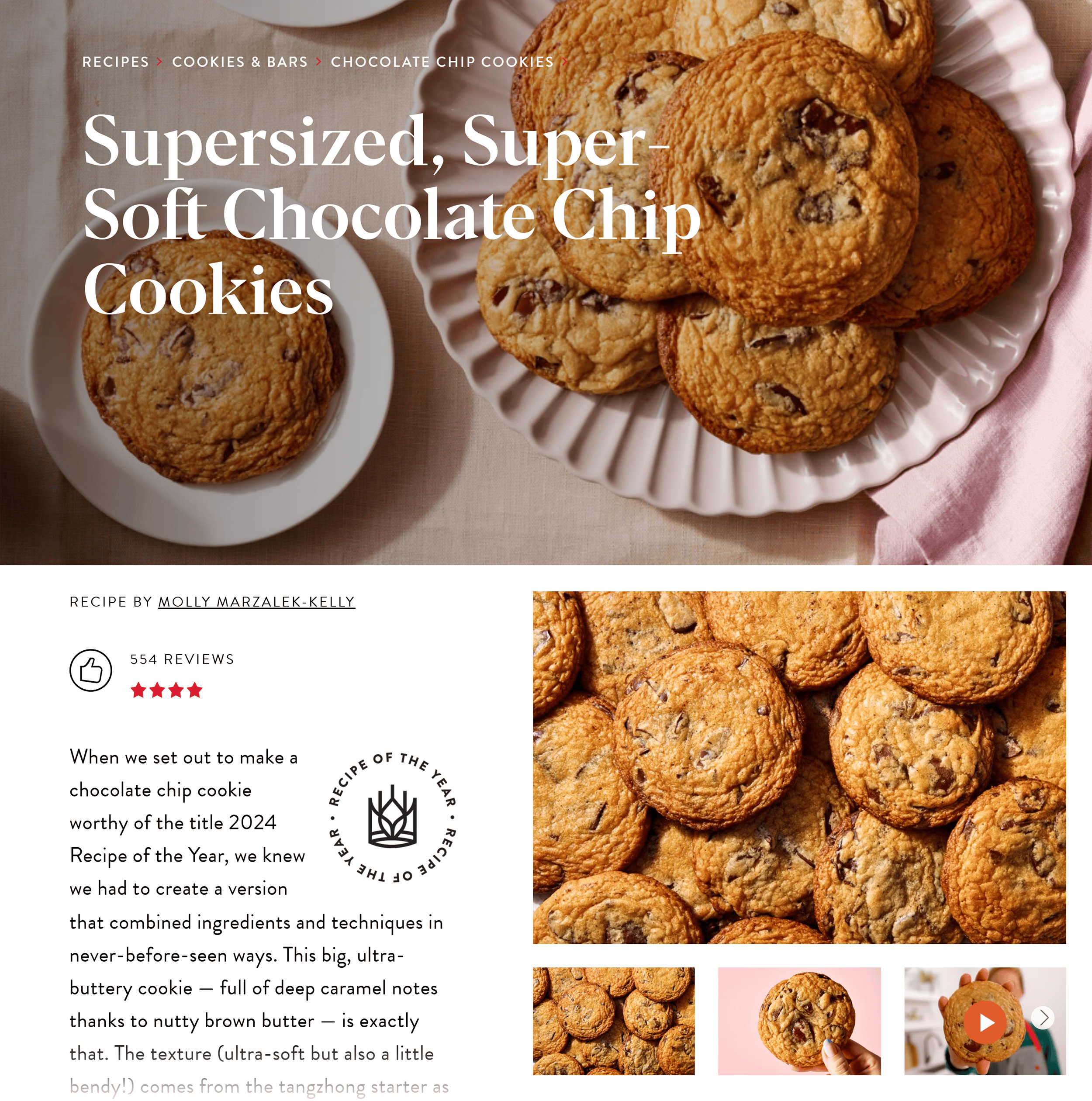
The video from their YouTube video is part of the image gallery at the top.
But it’s also spliced together with the step-by-step recipe instructions below.
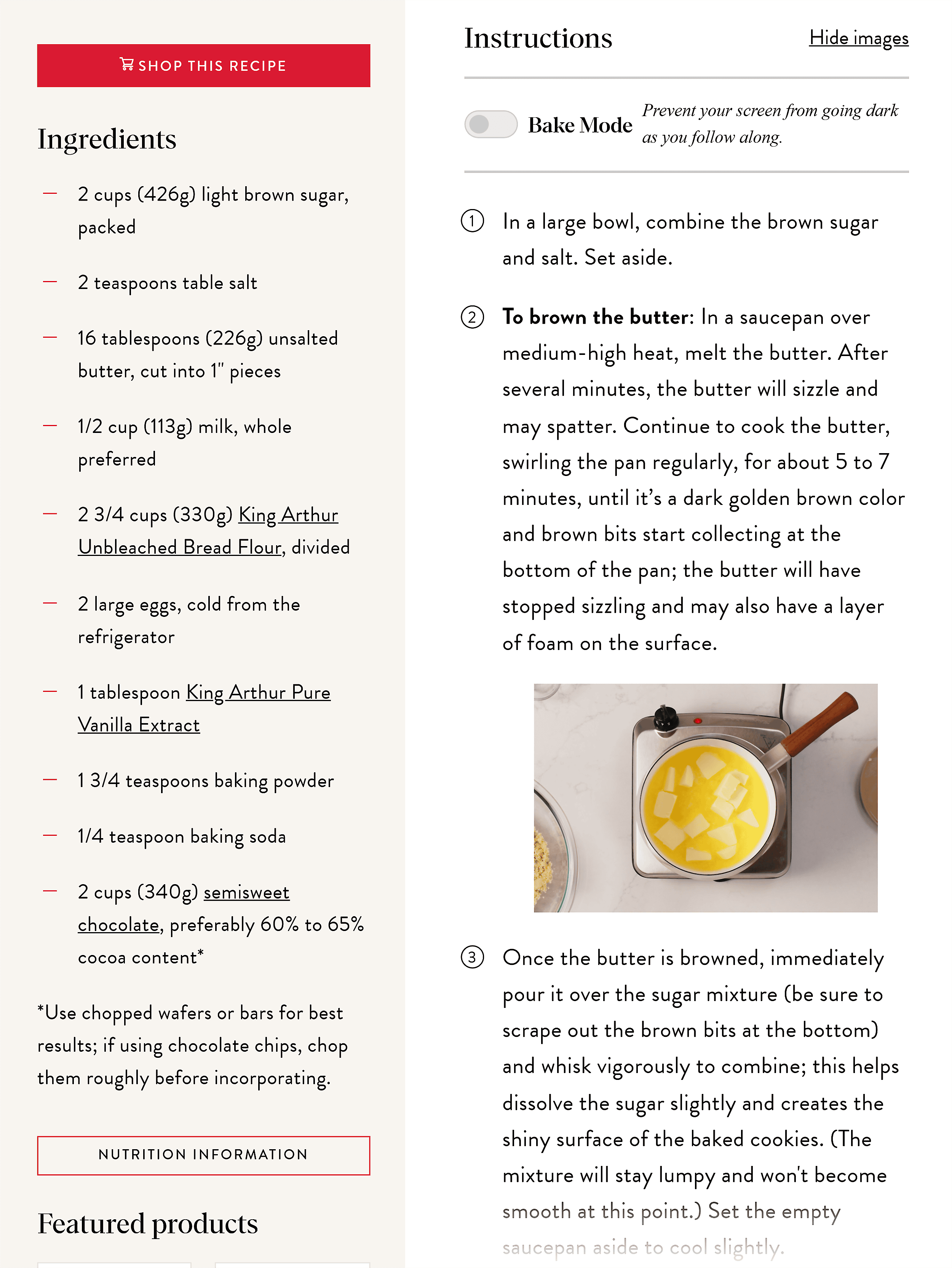
Doing this increases their chances of ranking for difficult keywords. And in some cases, they even rank more than once in the search results.
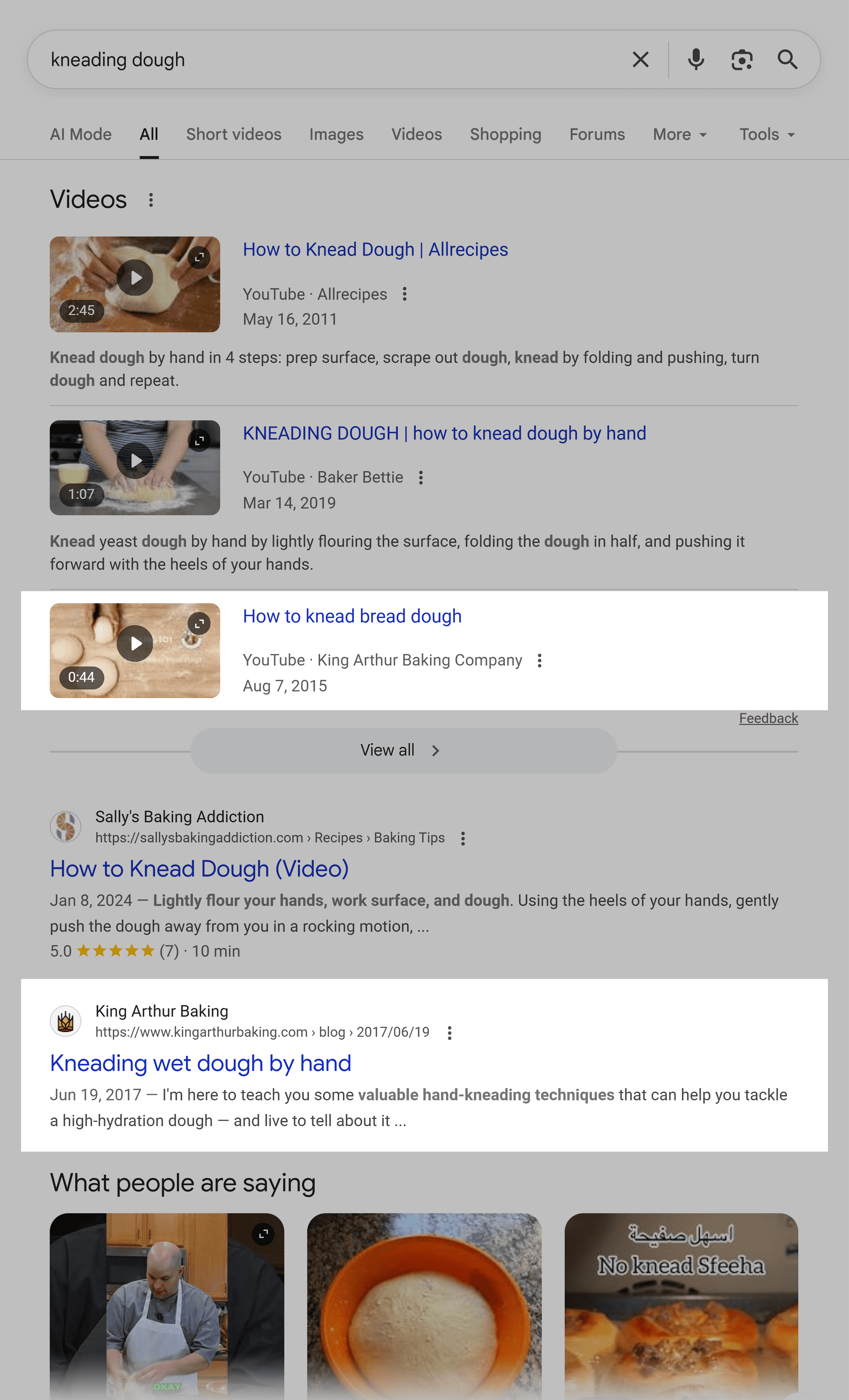
Key Lessons from King Arthur’s Bakery Blog
Google and AI won’t rank what they can’t understand, so giving clear structure and formatting to your blog is an essential first step to rank better.
For example, King Arthur uses schema markup for their recipes. This helps them rank in rich results on Google.
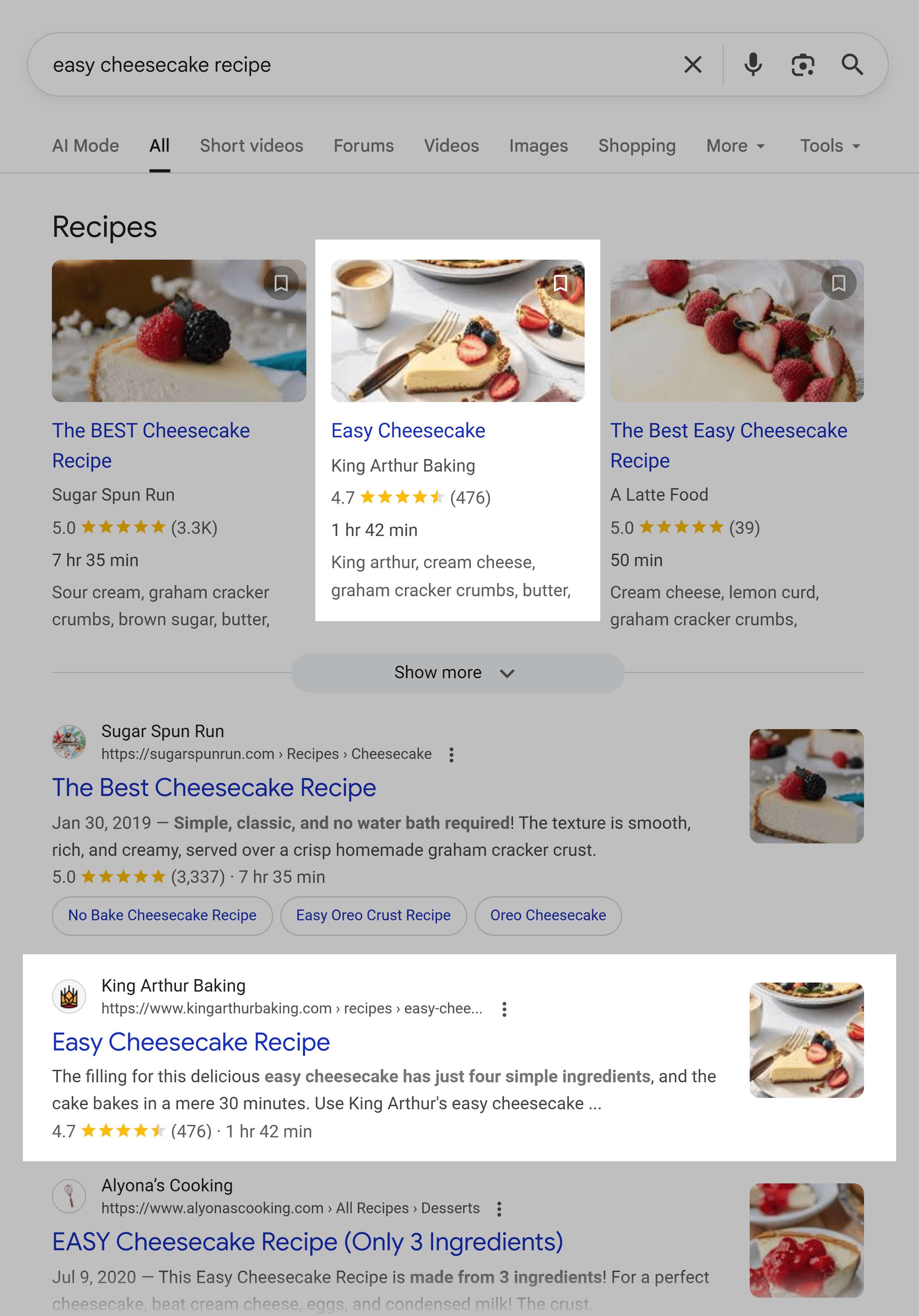
Another lesson from King Arthur is using multimedia when it makes sense. Try creating videos that show your products in action, or clearly answer a question that your audience is asking. These can help you increase time on page and appear in more search results.
Finally, know when to push your products. King Arthur does a great job of subtly adding their products to content.
For example, their blog posts include “featured products,” a CTA to “Shop this recipe,” and “Recommended for you” products at the end of each post.
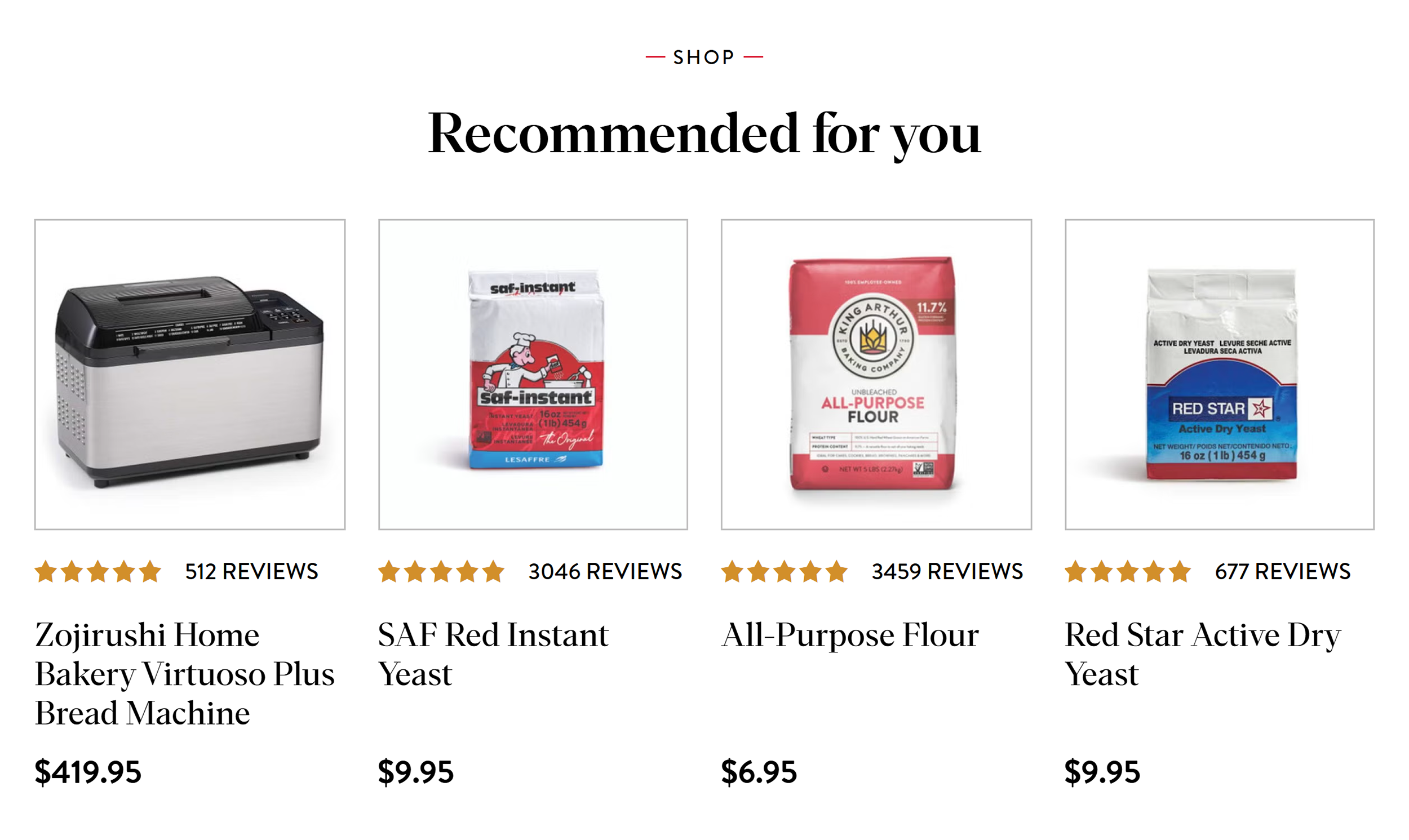
6. Keychron
- Industry: Electronics
- Organic blog traffic: 62.1K
- Backlinks: 7.1K
- Keywords: 25.8K
For a seriously niche blog and product, Keychron has a pretty hefty presence online. Their blog has had steady traffic growth since around 2020. And they rank for all kinds of keywords about keyboards.
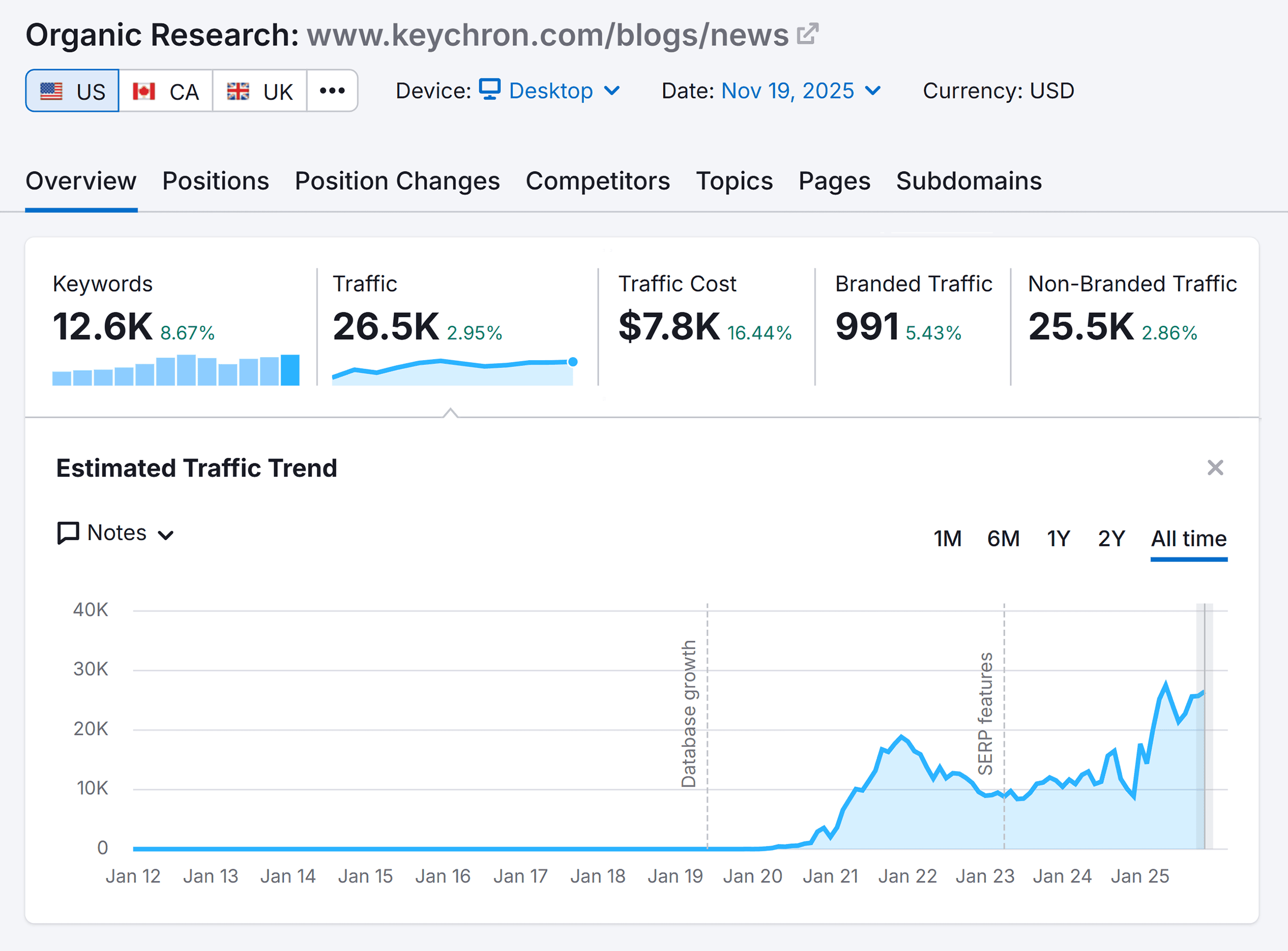
For example, this article about hall effect switches gets over 1,700 visits per month.
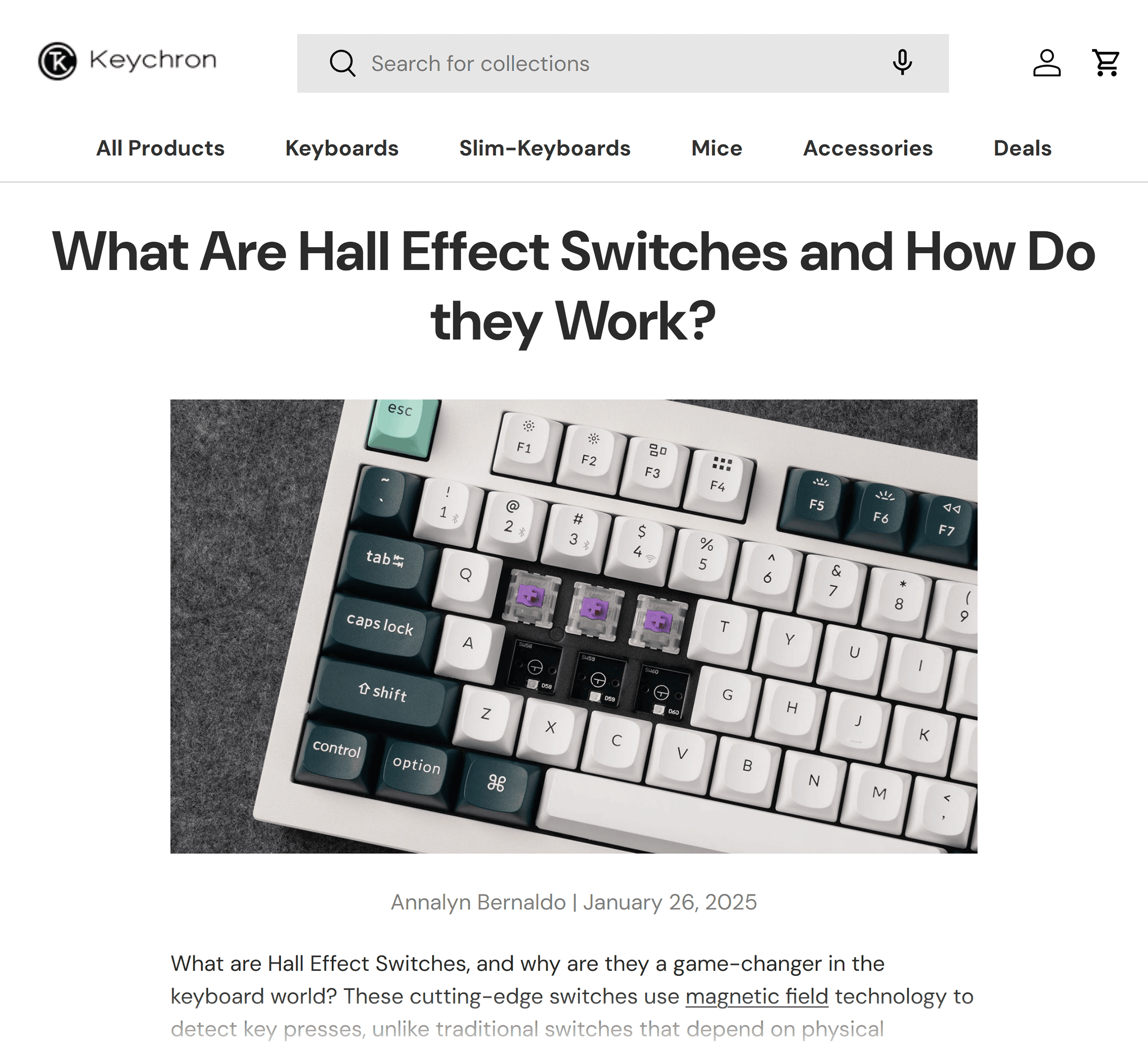
The post ranks #1 for that main keyword. But it also appears in search results, AI overviews, and image packs for 137 other keywords.

Their blog posts do a great job of using visuals to explain topics about the tech. And they get to gently promote their own products when appropriate.
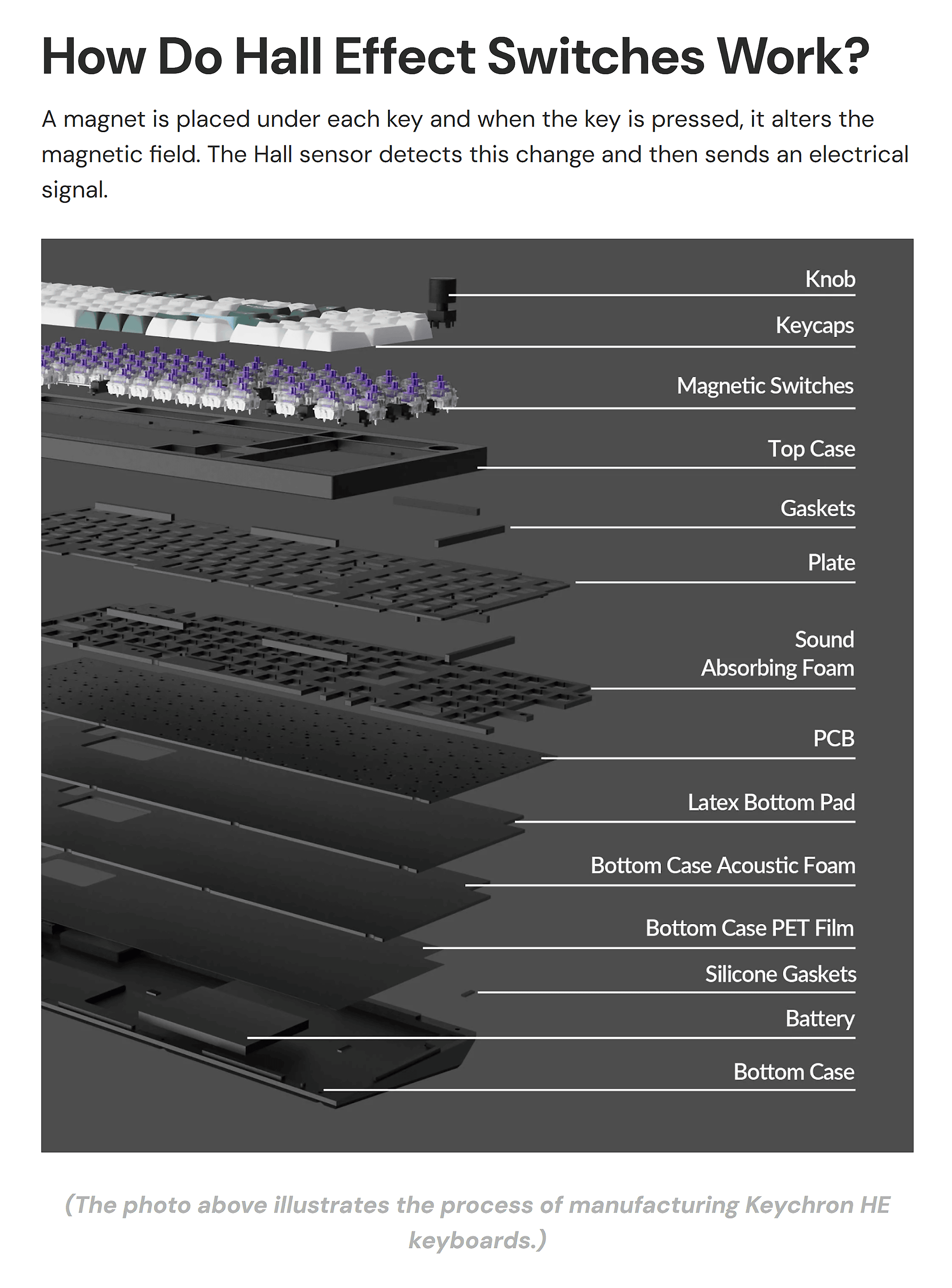
Of course, this kind of top-of-the-funnel content is likely to drive less traffic as more people rely on AI Overviews and other AI tools for quick answers to their questions.
But it can still drive some traffic. And careful linking and CTA placement can turn that traffic into conversions.
Key Lessons from Keychron’s Blog
One key takeaway from Keychron’s blog?
Don’t be afraid to go niche.
Your audience may have very deep knowledge of a topic (like keyboards), or they may be generalists looking for an overall view of the topic. It’s up to you to know who your audience is, and develop content for them.
Topics like “Best Keyboards for World of Warcraft” may seem niche, but it fits Keychron’s highly specific audience (and does a great job of showcasing their products).

Further reading: Audience Research: How to Know What Your Buyers Really Want
7. Huckberry
- Industry: Men’s clothing
- Total traffic: 57K
- Backlinks: 6.6K
- Keywords: 44K
What do you do when you’ve hit a peak, and suddenly everything comes tumbling down?
Here’s the story of Huckberry’s blog in one chart:

The root domain didn’t take as much of a hit. But the blog experienced a spike and a sudden drop around early 2021.
Thankfully, Huckberry didn’t let that stop them.
They still had another card up their sleeve: their YouTube channel.
While the channel was created back in 2016, there was no consistency, and hardly any views.
But sometime after traffic dipped on the blog, we see a change in the posting pattern on YouTube. Suddenly, they’re posting consistently.
They share video series, interviews, and more (some of which get hundreds of thousands of views).
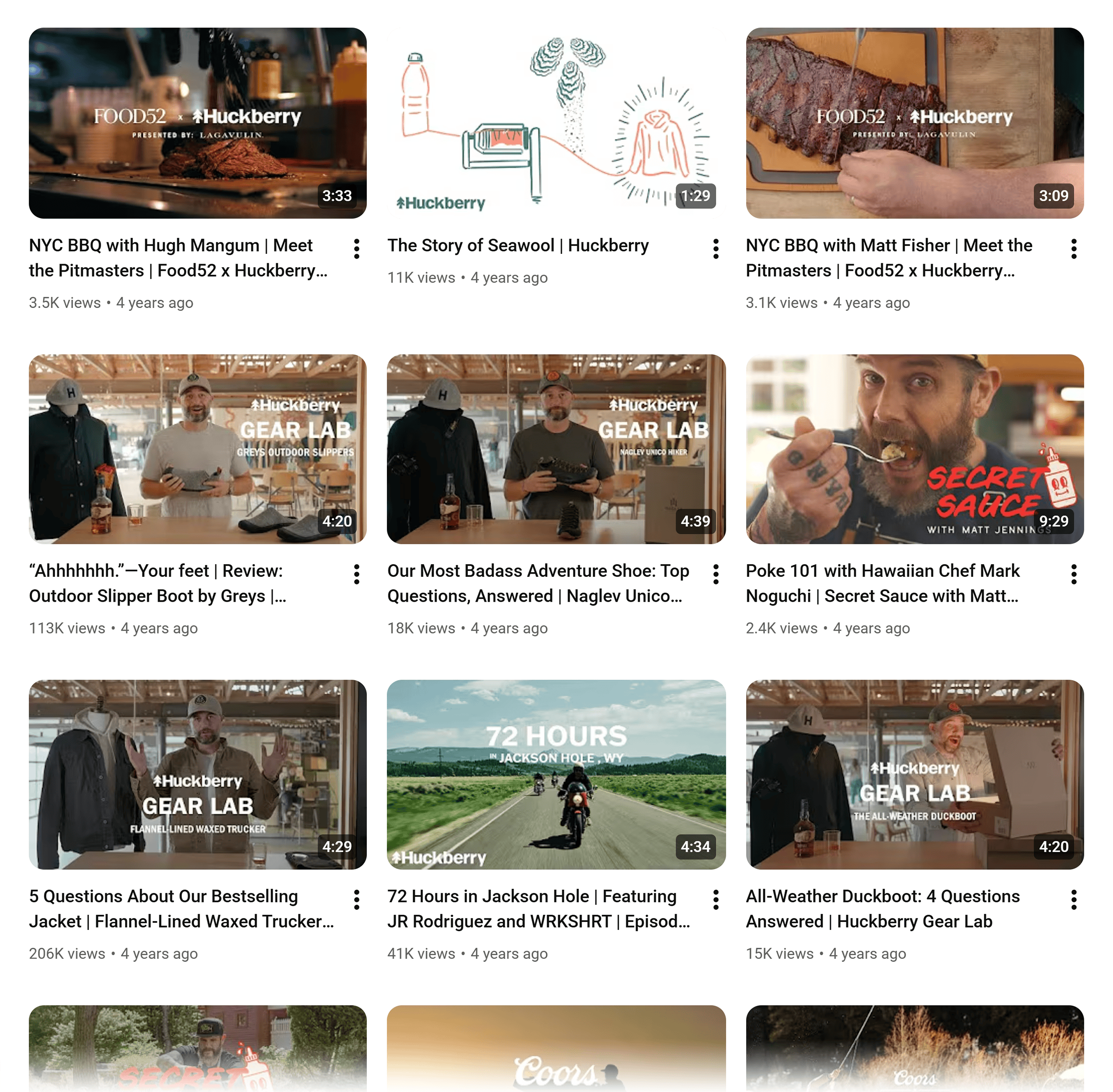
And over time, Huckberry became the go-to place for adventure content for men.
They started sharing videos about culinary travel and adventure stories with members of the community. Plus, they posted gear reviews that linked back to their products.
That multimedia strategy helped Huckberry’s blog gain consistent growth again. Plus, their YouTube channel took off — today, it boasts over 375K subscribers.

That video strategy made them adapt the way they present content on their blog as well.

Many posts include videos with gear reviews and style help. The videos are funny, personable, and mention the brand’s products without sounding like a sales pitch — it really sounds like two friends shooting the breeze.
The posts themselves also do a beautiful job of incorporating products:
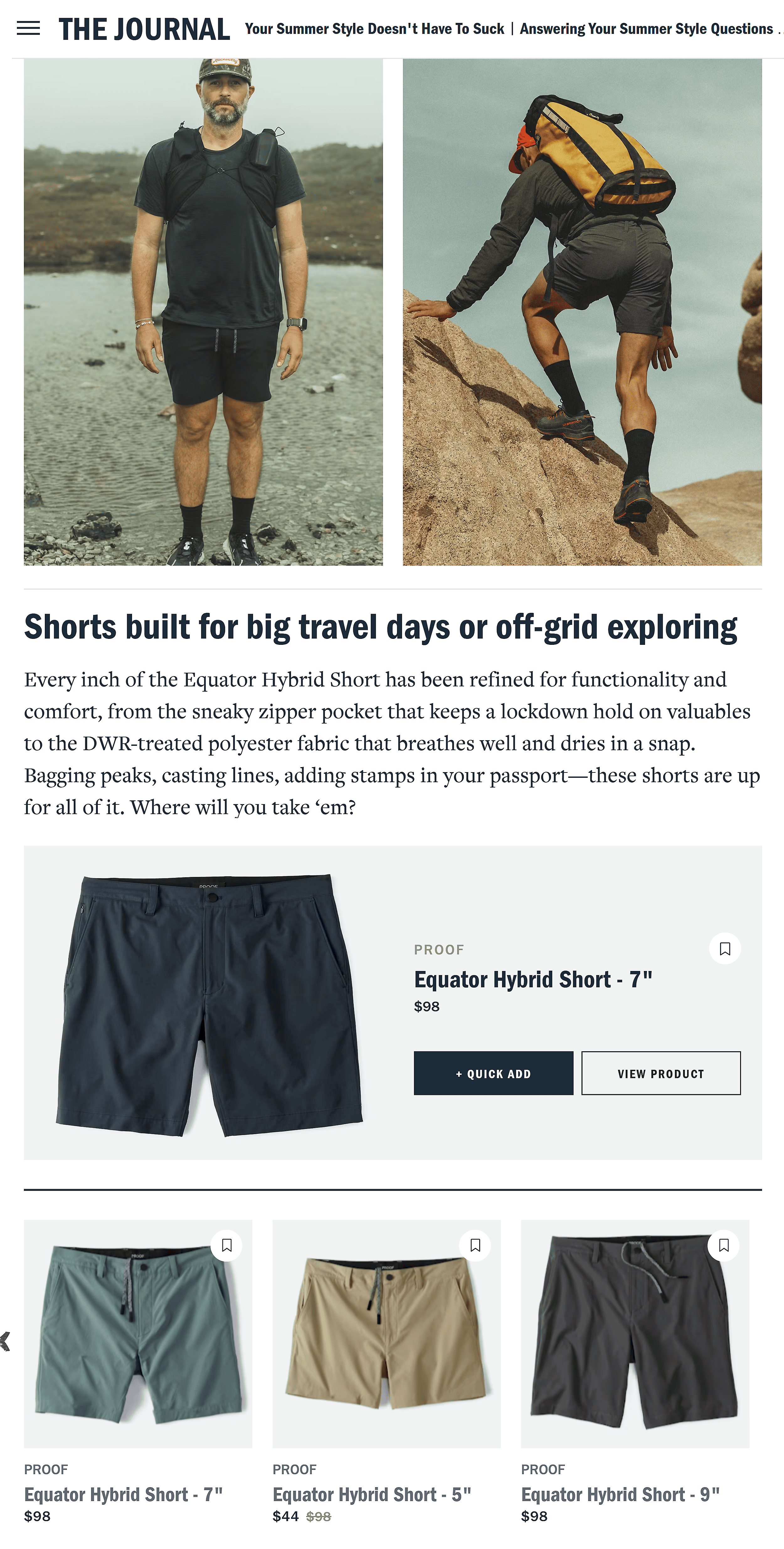
Almost all their posts follow classic blog post templates, but maintain the vibe of a cool online magazine.
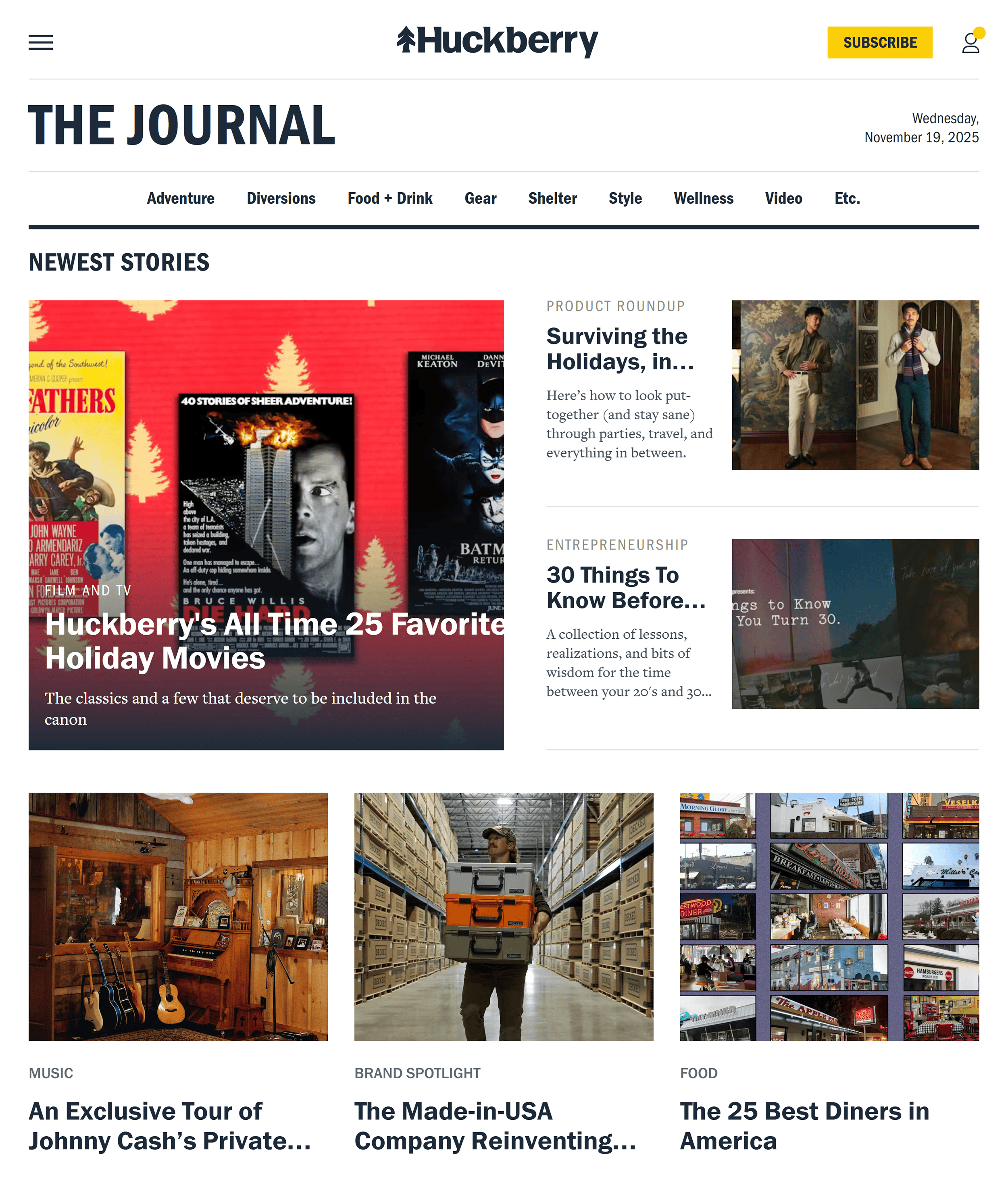
Key Lessons from Huckberry’s Blog
Huckberry’s key lesson is this: don’t give up after a traffic dip.
Blog traffic can dip for many different reasons, but it doesn’t mean your blog is a lost cause. When you see a dip, dig into the data.
Have you lost ranking on major keywords? Are clicks down? Run through a basic SEO checklist to make sure you’ve got your bases covered.
Then, go back to the question we’ve talked about before: What can you create that AI can’t replicate? Define how your blog is differentiated from what AI answers can deliver, and what value you can bring to your audience.
Your Ecommerce Blog Can Succeed — If You Trust the Process
You can’t build a successful ecommerce blog overnight. But the brands above prove it’s worth the effort.
When you do it right, your blog becomes more than a traffic source. It’s a growth engine that boosts visibility, builds trust, and strengthens your brand in both Google and AI search.
Keep answering your customers’ questions, stay focused on your niche, and build consistency over time.
But remember: your blog is just one piece of your overall strategy.
To go deeper into building a comprehensive marketing strategy for your ecommerce brand, check out our full ecommerce marketing guide.
Backlinko is owned by Semrush. We’re still obsessed with bringing you world-class SEO insights, backed by hands-on experience. Unless otherwise noted, this content was written by either an employee or paid contractor of Semrush Inc.



